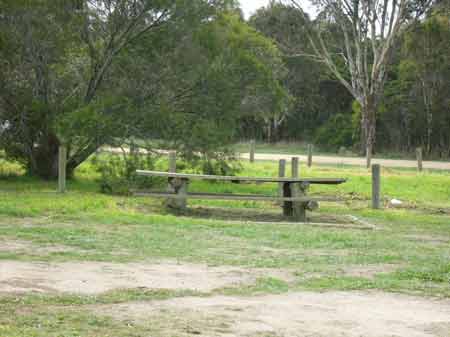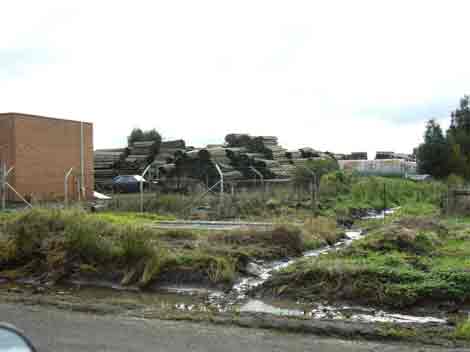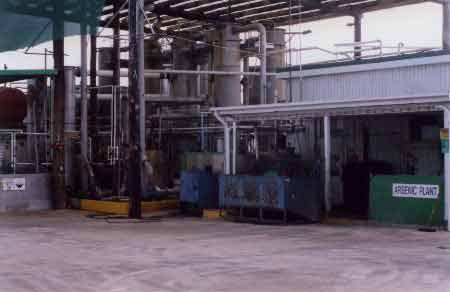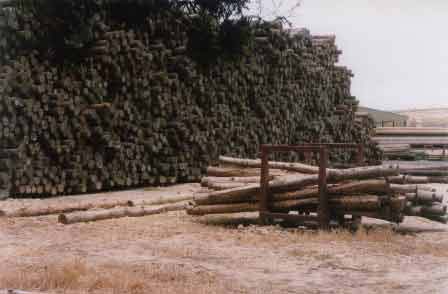EXPOSING DEVELOPERS WHO FAIL TO APPRECIATE AND RESPECT COMMUNITY, ENVIRONMENT AND SPIRIT OF THE LAND
TOXIC TIMBER REGULATORS "STILL ASLEEP AT THE WHEEL"
Photo: 2003 Treated Pine Playground SouthWestern Vic. In 2015, it's still there. How many children have played here over the past decade or more?
May 2015: Various Australian states continue their legislative black hole to prohibit use of CCA products, despite APVMA recommendation to ban the use of CCA in certain situations Although it was assumed [by everyone] that use of CCA "...garden furniture, picnic tables, exterior seating, children’s play equipment, patio and domestic decking, and handrails.” was prohibited in Australia as a result of APVMA 2005 Review CCA.
However, this is not the case as the photos below show that CCA treated timber is still being used in South Australia for (1) house patio decking and a table (2) and table [food] furniture outside a bakery. And although statements made by APVMA /industry [see below ] say that these treated timber are not permitted , in South Australia there is no State Government /Local Government, legislation/ building laws act enacted [in place] to prevent these products being used. And its most probable that all other Australian States have NOT ENACTED any legislative measures to prevent these CCA products [ recommended by APVMA] being used.
Ref: APVMA CCA Report of review findings and regulatory outcomes Summary Report 3/2005 Executive summary page 1 "--Product labels be varied such that uses of CCA timber treatment products are not permitted for timber intended for use as garden furniture, picnic tables, exterior seating, children’s play equipment, patio and domestic decking, and handrails.”
And Ref: A Fresh Look of Credibility Treated Timber Industry turns the corner Australasian Timberman June 2006 “---new laws legislate that CCA preservative chemical may not be used for treating timber intended for use as garden furniture, picnic tables, exterior seating, children's play equipment, patio and other decking boards and domestic handrails in Australia.”
And Koppers Safety Sheet 2014 Safety Precautions page 3 CCA-treated timber should not be used in the following situations/applications: (d) Where it may be in regular contact with skin (e.g., garden furniture, picnic tables, exterior seating, children play equipment, patio and domestic decking, and handrails).

May 2015 South Australia: (1) CCA House Patio decking and table
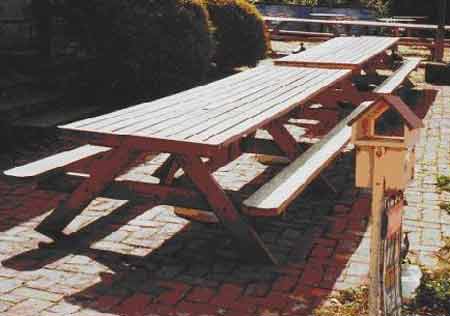
May 2015 South Australia: CCA seats and tables outside a South Australian bakery. How many kids will be exposed to arsenic after being sitting on these seats and eating from these tables?

May 2015 South Australia: CCA seats and tables outside a South Australian bakery.
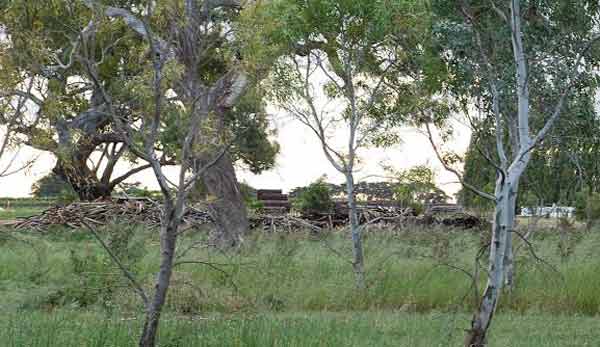
Photo: Coonawarra South Australia Jan 2015. Thousands of CCA vineyard posts continue to leach Arsenic and Chromium well past their use by date. Federal and State regulatory bodies are next to useless in dealing with this widespread and increasing problem. How many more vineyards are dealing with their waste posts this way?

Photo: Coonawarra South Australia Jan 15: Abandoned CCA pine next to a very large dug out pit (approx 250m from the main road) - one of the largest vineyard companies in Coonawarra. Hard to say how many posts - perhaps 15,000 lie here leaching their toxic legacy for how long? Has the soil and groundwater been tested here for Arsenic and Chromium contamination?
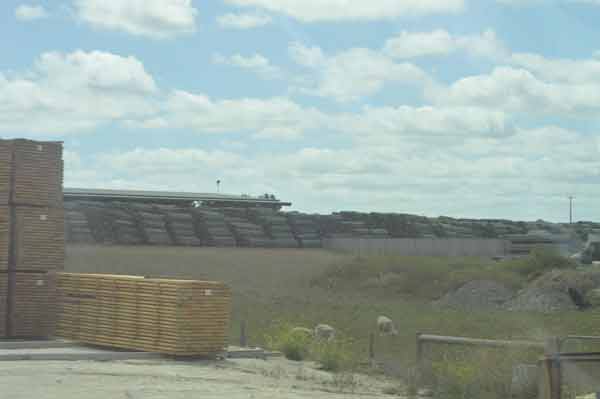
Picture Feb 2015: CCA production facility: Mt Gambier.

Picture Feb 2015: CCA production facility: Mt Gambier. 30.7 million CCA posts in SA Vineyards 2008, 1 million CCA post breakages/year in SA 2008 (at 3% breakage per SA EPA formula), 71.5 million CCA posts in Australian Vineyards 2008.
Page Contents:
May 2013: Dangerous Levels of Arsenic Detected in Air (Wellington New Zealand)
June 29 2012: New Restrictions In Place For Arsenic Treated Timber
http://www.apvma.gov.au/news_media/media_releases/2012/mr2012-02.php
April 2 2012: Regulators Fail To Implement Toxic Timber Bans
March 2012: CCA Pine Still Being Sold in Australia Without Proper Safety Information Presented To Consumers - Obvious signs of Regulatory Black Hole.
Re point of Sale Information on CCA. We do have a real problem here with retailers. I checked local Mitre 10 store today. It was as I thought, they do not provide the public (and have no intention to do so ) with any CCA information brochures, hand out safety sheets etc. I remarked to senior store staff [who was aware of issues with CCA] that if you purchase CCA treated timber at your store & most cutomers are not aware of hazards/safety issues with handling treated timber CCA and customer should be informed by store staff at point of sale.
Some of the remarks made to me by senior Mitre 10 store staff yesterday 7/3/2012. (1) Its up to consumer/customer to find out about treated timber products [CCA] ---- this safety information about treated timber products[CCA] is readily available on web sites. (2) Additional cost for store to provide this safety information about treated timber products 3(3) And [worst] comment -- there is no legal /regulation in South Australia to compel store to provide safety information at point of sale to customer on using treated timber [CCA] etc--- so we don't do it!!
These people [retail stores] have no conscience on possible health risks to customers of not using safety precautions when handling treated timber products[CCA]. However, in past years at this same Mitre 10 store my inquiries on CCA safety measures, I found that their staff [employees] who are handling treated timber [CCA] were well aware of the safety measures that they should take when handling treated timber at the store site (eg) wearing goggles, gloves etc , [whereas this same company [Mitre 10] in stark contrast fails to inform the customer at point of sale of the safety hazards in using these products [CCA].
Called some 4 Bunnings Stores In Victoria (13/3/12). One of the stores said that they don't sell any CCA timber, only Ecowood (Koppers Arch Tanilised E (Copper & Azole). Another store said that schools don't use CCA anymore and that the only problem is with burning it and that only 0.8% of the timber has arsenic in it. No data provided at store and if you want to know more you have to look on internet. Another Bunnings said that there was no drama in using it for posts. The last store said that the arsenic treatment used to be very bad – there is still a tiny amount of arsenic used but is now safe to use. Only the manufacturers of the product know about the substance, Bunnings suppliers don't know either. Store doesn't provide any information to customers.
March 2012: Government Processes Stall for 6 years (and counting) on Restricted Chemical Product Status For CCA pine.
Friday Offcuts 27/5/2011 Following its 2006 review of CCA preservative treatment for timber, the Australian Pesticides and Veterinary Medicines Authority (APVMA) indicated its intention to designate CCA a Restricted Chemical Product (RCP). This meant CCA chemicals would only be able to be supplied to or used by authorised persons having the necessary accredited training and where special equipment was employed, such as a preservative treatment plant. The treatment industry has, effectively, been on notice since the original review and the APVMA is now acting to address this matter with the designation of CCA as an RCP expected in the coming months. AFPA is liaising with DAFF with the aim of achieving adequate coordination between APVMA and relevant State and Territory authorities to ensure a smooth transition. A plant largely complying with AS/NZS 2843:2006 will most likely be seen as the bench mark for such operations. Appropriate documentation will be required to demonstrate compliance with the standard. Treatment companies should be aware of and, if necessary, prepare for this impending change to the status of CCA chemical use. The relevant State and Territory authorities are listed in the standard. Source: AFPA Canopy A licence or permit from the relevant authority is required for a treatment plant to use an RCP. These authorities are currently considering how they will legislate, regulate or authorise the use of CCA chemical.
CCA as a Restricted Chemical Product ' How the RCP status for CCA affects treatment operations Para #2 which states : "A treatment plant cannot legitimately use a Restricted Chemical Product without the state in which it operates legislating or authorising the use of that chemical. Thus, the RCP status of CCA is dependant upon enabling legislation from state and territory authorities that govern the operations of treatment plants. After this time the CCA manufacturers will not be able to supply the preservative to other than authorised persons, who have successfully completed accredited training in handling and use of the chemical. In addition, the APVMA has indicated that treatment plants using CCA should largely comply with the requirements of plant design and operation, as set down in the AS/NZS 2843, Parts 1 and 2, and it is expected that the enabling legislation enacted at state level will include this requirement.----"
October 31 2010: Toxic Timber (Landline ABC TV): Much discussion about Vineyard Posts
August 5 2010: Residents angry at lethal poison in suburb (Methyl Bromide)
April 18 2007: U$2.5M penalties for preservative price fixing
October 31 2007: SBS TV features dangers of CCA timber on the excellent 'Is Your House Killing You?"
Updates since June 2006
| Nov 06: A Revision of the use of Chromium in CCA Treated Timber | |
|
Late 2006: CCA
Review Post-review activities
|
|
|
April 07:
Business Age Letters
|
Other Timber Treatments of concern include; Creosote (USA reviewing, EU pushing to ban), Tributyltin Naphthenate (TBTN) (Banned in US and Europe) and Tributylin Oxide (TBTO) (Banned in US and Europe).
Good Links:
National Pollution Inventory Fact Sheets
April 2007: This CCA timber picnic table near the Victorian town of Rosedale continues to be used despite authorities knowing CCA timber is unsafe. How many other unsafe CCA structures are still in use in Australia putting users of such structures at risk.
Are you eating arsenic with your picnic? By Sharon Beder August 13, 2008 The Courier-Mail
THEY'RE panicking in Indiana, US. When TV news show 13 Investigates tested the surface of picnic tables there recently, it found high levels of arsenic. Now, thousands of picnic tables are being removed from parks or painted with an oil-based stain. The picnic tables are made of timber treated with copper chrome arsenate (CCA), used in most of Australia's park picnic tables. Should we also be panicking?
Scientists have demonstrated that arsenic leaks out of CCA-treated timber, even 20 years after it has been treated. It is also known that exposure to arsenic can cause cancer. According to the World Health Organisation, arsenic is a known carcinogen and is acutely toxic. It can cause lung, bladder and skin cancer, as well as reproductive and neurological problems. But is there enough arsenic in Australian picnic tables to cause such dire consequences? We don't really know because no one has done wipe tests. Without such data, and given the high levels of arsenic found by such studies overseas, can we be complacent about the risks involved?
Some nations have taken a precautionary approach. CCA-treated timber has been banned altogether in Switzerland, Vietnam and Indonesia and severely restricted in Japan and Europe. In 2005 the Australian Pesticides and Veterinary Medicines Authority cancelled the use of CCA for treating timber destined for garden furniture, picnic tables, exterior seating, children's play equipment, patio and domestic decking and handrails. But should we be worried about the picnic tables (and play equipment) already out there in our parks and on our beaches? Should our councils be allowing parents and children to eat food off treated timber picnic tables that could be coated in arsenic?
People can be exposed to arsenic through touching CCA-treated timber because surface arsenic sticks to human skin. It then can be transferred to the mouth, for example by subsequent handling of food. It also can be transferred to the mouth by eating food placed directly on CCA-treated surfaces. Yet how many people think twice about eating off council picnic tables? Surely that is what they are there for?
The APVMA claims it has no power to control how people use the structures made from CCA-treated timber. It is local councils that control the ongoing use of existing picnic tables. Local councils may be comforted by the fact that picnic tables have been around for many years and no one has yet set out to prove that they got cancer from them. But who would dream that their lung or bladder or skin cancer might have been caused by eating off picnic tables in their youth? Especially given that Australian authorities didn't admit to the potential problem until recently. The lack of past lawsuits will not provide comfort to the wider community. Perhaps only tests showing picnic tables are arsenic-free will do that. Otherwise there might be good reason to follow Indiana park authorities and do something about all those picnic tables. Sharon Beder is a professor at the School of Social Sciences, Media and Communication, University of Wollongong.
see also Treated timber in playgrounds could poison kids Courier Mail - Australia
APVMA Review Recommendations (March 2005)
10.1 Label Directions
It is proposed that CCA labels be varied by:
i. requiring that timber treatment facilities be designed and operated to meet appropriate Australian Standards (AS/NZS 2843.1:2000 and AS/NZS 2843.2:2000).
ii. not permitting uses of CCA timber treatment products for timber intended for use as garden furniture, picnic tables, exterior seating, children's play equipment, patio and domestic decking, and handrails.
iii. specifying that CCA products may be used for preservative treatment of timber and timber products intended for the following end uses: piling and other structure foundations, residential construction, industrial and commercial construction, rura and farm use, fencing, poles, landscaping timbers, fresh and salt water structures, signage and boat construction.
iv. requiring each timber piece treated with CCA (except specific circumstances where supplied and therefore marked as a pack) to be legibly and durably marked (at least to the point of the first person who uses the treated timber) with a treating plant identification number, hazard class and chemical number, as well as the statement:
"TREATED WITH COPPER CHROME ARSENATE"
v. including more detailed instructions for application, mixing and vacuum/pressure operations, management of freshly treated timber, management of liquids, sludge or waste material containing CCA residues of wildlife, fish, crustaceans and the environment, and storage and disposal...
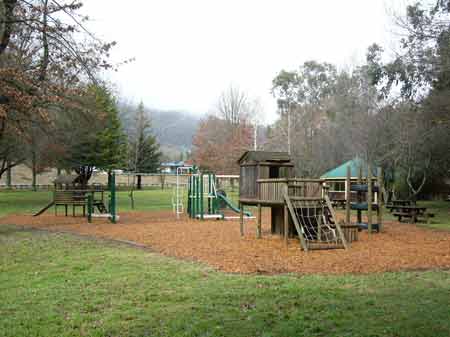
July 07: Treated pine playground, Harrietville Victoria still in use.
Swipe tests conducted by Croydon Conservation Society earlier in the year at a treated pine playground in Melbourne's eastern suburbs, revealed that 710 micrograms of arsenic, 630 micrograms of chromium and 670 micrograms of copper were wiped off the surface of a school playground. Click here for further details. Channel 9's A Current Affair also conducted tests and found similiarly worrying results. See here.
Q: How many treated pine posts in this 100 hectare vineyard? A: Between 50,000-80,000!!! What happens to the posts after useby date?
The Issue
(Photo Above): Arsenic plant at Koppers Arch treatment facility in the Victorian town of Trentham - Coliban River catchment. Koppers Arch and Osmose are the sole producers of Copper Chrome Arsenate in Australia. Koppers Arch is a subsidiary of the US multinational Koppers Inc.
Problems with the Fixation Process
Site Contamination
Limited Penetration of CCA
Disposal Issues
Current Applications of CCA Timber
Pollution
Playing it safe on treated timber
Restricting the use of a potential carcinogen in playgrounds makes sense.
A proposal by Australia's chemical regulator to restrict the use of arsenic-treated timber in playgrounds and for decking, handrailsand outdoor furniture ought not to come as a surprise. The use of copper chrome arsenate (CCA) as a timber preservative has been widespread since the 1960s. Treated timber is used extensively in Australia, New Zealand and North America. The wood, usually plantation-grown pine, is impregnated using a vacuum pressure process that protects vulnerable sapwood from insects and fungal decay. The product has been the source of lingering safety concerns in the community for many years. A report by New Zealand's Environmental Risk Management Authority sums up the matter succinctly: "CCA-treated wood has been in use for many years without discernible health effects. However, there is no question that CCA is a toxic chemical."
CCA is a mixture of copper, chrome and arsenic - all materials with varying degrees of toxicity. The toxic nature of arsenic is well understood in the community, which has relied on assurances from timber industry groups that its use as a preservative poses no significant threat. According to the World Health Organisation, arsenic exposure causes various cancers, including lung, bladder and skin varieties. While there is no evidence that normal use of the product has been responsible for adverse human health effects, doubts remain, especially in relation to the use of CCA-treated wood in areas used by children and where food is prepared or eaten. Some international studies have suggested that the arsenic in treated wood could be absorbed via the skin or inhaled or ingested accidently. The greatest known dangers arise from the occupational exposure during the treatment of the product and burning of treated wood.
Pressure to regulate the future use of CCA-treated timber intensified after the US Consumer Product Safety Commission found the wood "could be a significant source of arsenic" ingestion by children. The US timber industry will move away from CCA treatment by the end of this year in favour of other wood preservatives. The European Union will also largely prohibit its use from June next year. It is already banned in several other countries. The draft report by the Australian Pesticides and Veterinary Medicines Authority is subject to public comment until the end of February. At this stage the regulator is erring on the side of caution in suggesting limited future use. This is as it should be. Suitable, safer alternatives to CCA are available. In that light, continued use of chemical that may pose a threat to public safety in such circumstances is hard to justify. Moreover, if the regulator is concerned enough to propose restrictions on future use of the product, then surely the continued use of existing playgrounds and other facilities where CCA is present must also be called into question pending further research.

CCA pine decking
Friends of the Earth Melbourne Press Release 23/12/03
APVMA REVIEW OF TREATED PINE DOES NOT GO FAR ENOUGH
Friends of the Earth today warned that yesterday's announcement by the Australian Pesticides and Veterinary Medicines Authority (APVMA), that a decision regarding its final recommendation regarding Copper Chrome Arsenate (CCA) will not address all of the problems associated with the toxic chemical treatement.
The APVMA has announced that it will not make its final recommendations on arsenic timber treatments until 2004.
Friends of the Earth spokesperson Anthony Amis said, "Fundamental problems such as disposal of treated pine and issues surrounding existing structures seem to have been given a wide berth by the APVMA. Our organisation also has concerns that the APVMA appears to believe that leaching of arsenic is not a significant risk to the environment".
"Australia is about to experience an exponential growth surge in the amount of toxic timber that has reached its use-by date. We still have no adequate policies that will address what we end up doing with all of this waste - which could amount to almost one million cubic metres of timber per year in the future. Friends of the Earth remains concerned about the potential leaching of arsenic, chromium and copper into groundwater underlying landfill sites. This matter has recently been uncovered in Florida" said Mr Amis.
"We also know that contamination of soil and groundwater underlying treated timber mills may well be a massive national environmental problem. Past spills of CCA may still well threaten drinking water supplies in towns such as Mount Gambier. It is unfair for the APVMA to dismiss environmental concerns as insignificant.
The Australian wine industry is by far the largest consumer of treated pine products. We have heard that vineyards are stockpiling old treated pine posts and in some cases people are burning these stockpiles with potentially lethal impacts on the natural environment and people living downwind of these sites. Burning of CCA pine is probably the worst way to deal with this timber as the smoke contains potentially carcinogenic toxins.
Recently conducted research from Florida has revealed that CCA timber may in fact become more toxic with age. This means that it is impertative that the APVMA support initiatives that will independently assess existing CCA structures built under Australian conditions. The APVMA needs to co-ordinate a national testing program on selected treated timber sites, including playgrounds and houses to determine the extent of the problem. To warn people that CCA timber could cause cancer and then to ignore the enourmous task of dealing with existing treated pine structures is simply passing the buck" added Mr Amis.
"We urge the APVMA, Federal, State and Local Governments to adequately resource independent testing of existing structures as soon as possible. It is outrageous to accept the fact that children will continue to play on CCA structures such as playgrounds and house decks that may well continue to leach cancer causing chemicals indefinately" concluded Mr Amis.
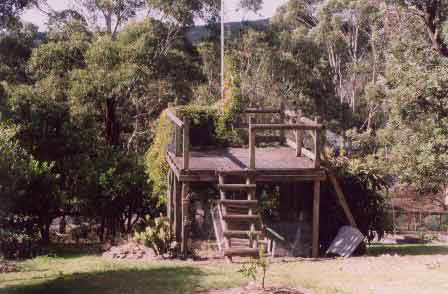
Treated pine structures in backyards are commonplace.
The Age - 23/12/03. Cancer alert on treated timber - Sean Nicholls, Stathi Paxinos
Australia's chemical regulator has proposed banning the use of arsenic-treated timber in outdoor play equipment, decking and furniture, saying frequent exposure to it may put people at "undue risk".
The regulator will also consider calling for existing structures made of treated pine and other arsenic-laced materials to be removed from thousands of backyards, schools and children's playgrounds across Australia.
The Australian Pesticides and Veterinary Medicines Authority yesterday released the findings of its review of copper chrome arsenate (CCA), a chemical used to combat rot in pine products, after increasing international pressure to phase out is use over fears it may cause cancer.
The authority's principal scientist, David Loschke, said the review was particularly concerned with children aged between three and five. "We didn't get enough evidence to give us that answer. Therefore we must recommend these uses are stopped."
A United States study this year found frequent exposure to CCA-treated play equipment greatly increased a child's risk of developing bladder and lung cancer, prompting the Australian review.
The Australian regulator wants labels to prohibit the future use of CCA in specific products and a method for easy identification of CCA-treated timber. But it wait for the results of a major study by the US Environmental Protection Agency, due early next year, before deciding if existing structures pose a significant enough health risk to recommend their widespread removal.
Yesterday's recommendations have been put out for public comment until February 29.
Australia is the world's third highest per capita user of CCA-treated pine after New Zealand and the US, with about 800,000 cubic metres produced locally each year. While the use of arsenic-treated timber in public playgrounds is being phased out by councils, it is still present in play equipment in child-care centres and schools across Australia.
A timber preservation industry official last night criticised the regulator's report, saying it contained "major inconsistencies".
Harry Greaves, chairman of the Timber Preservers Association of Australia's technical committee, said: "Clearly the APVMA have taken a very precautionary approach to this. They don't know (what the risks are) either, so they've erred on the side of caution. I think that's a pretty poor precedent to set for a chemical that's been around for 70 years.
A Bracks Government spokeswoman said Education Services Minister Jacinta Allan had not yet seen the report. She said the Government would examine the report in consultation with school councils, which were responsible for school playgrounds. She would not comment on the fate of existing school playgrounds.
Opposition Education spokesman Victor Perton said the chemical regulator had correctly taken a conservative approach in recommending that treated pine not be used in future structures. "As for existing structures, I think everyone . . . will need to look closely at the follow-up studies by the American and Australian authorities," Mr Perton said.
"It is important that people don't panic because the study indicates that no one has any idea how much arsenic adheres to children's and adult's hands after contact with this type of furniture."
Municipal Association of Victoria president Brad Matheson said many councils were in the process of replacing treated pine playgrounds, which had been used for decades because it was the cheapest material, with plastic and metal structures.
"Councils will be watching this with a great deal of interest because it will have impact on risk management strategies in terms of ensuring that we can limit liability in relation to local government," Mr Matheson said.
A Friends of the Earth spokesman said there was also concern that treated pine was being found in garden mulch.
The following information comes from Canada - deborahbarrie@hotmail.com
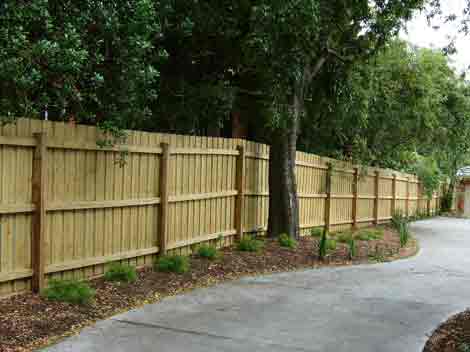
January 2005: Almost all new fences in Melbourne are now made from CCA timber. The timber lasts only for a few years and then has to be disposed via landfill, where the toxins leach out of the timber.
What happens to arsenic when it enters the environment?
Arsenic cannot be destroyed in the environment. It can only change its form. Arsenic in air will settle to the ground or is washed out of the air by rain. Many arsenic compounds can dissolve in water. Fish and shellfish can accumulate arsenic, but the arsenic in fish is mostly in a form that is not harmful.
How might I be exposed to arsenic?
Eating food, drinking water, or breathing air containing arsenic. Breathing contaminated workplace air. Breathing sawdust or burning smoke from wood treated with arsenic. Living near uncontrolled hazardous waste sites containing arsenic. Living in areas with unusually high natural levels of arsenic in rock.
How can arsenic affect my health?
People phone and ask questions like, should I buy a home with a pressure treated wood basement and I let them know of studies that show the occupants of these homes are becoming ill. Breathing high levels of inorganic arsenic can give you a sore throat or irritated lungs. Ingesting high levels of inorganic arsenic can result in death. Lower levels of arsenic can cause nausea and vomiting, decreased production of red and white blood cells, abnormal heart rhythm, damage to blood vessels, and a sensation of "pins and needles" in hands and feet.
Ingesting or breathing low levels of inorganic arsenic for a long time can cause a darkening of the skin and the appearance of small "corns" or "warts" on the palms, soles, and torso. Skin contact with inorganic arsenic may cause redness and swelling. Organic arsenic compounds are less toxic than inorganic arsenic compounds. Exposure to high levels of some organic arsenic compounds may cause similar effects as inorganic arsenic.
How likely is arsenic to cause cancer?
Several studies have shown that inorganic arsenic can increase the risk of lung cancer, skin cancer, bladder cancer, liver cancer, kidney cancer, and prostate cancer. The World Health Organization (WHO), the Department of Health and Human Services (DHHS), and the EPA have determined that inorganic arsenic is a human carcinogen.
How does arsenic affect children?
We do not know if exposure to arsenic will result in birth defects or other developmental effects in people. Birth defects have been observed in animals exposed to inorganic arsenic. It is likely that health effects seen in children exposed to high amounts of arsenic will be similar to the effects seen in adults.
How can families reduce the risk of exposure to arsenic?
If you use arsenic-treated wood in home projects, you should wear dust masks, gloves, and protective clothing to decrease exposure to sawdust. If you live in an area with high levels of arsenic in water or soil, you should use cleaner sources of water and limit contact with soil.
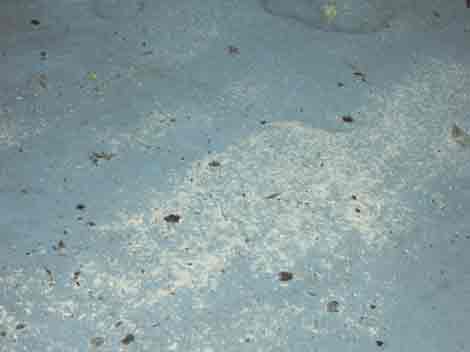
January 2005: CCA sawdust left on floor after sawing CCA treated timber.
Is there a medical test to show whether I've been exposed to arsenic?
There are tests to measure the level of arsenic in blood, urine, hair, or fingernails. The urine test is the most reliable test for arsenic exposure within the last few days. Tests on hair and fingernails can measure exposure to high levels or arsenic over the past 6-12 months. These tests can determine if you have been exposed to above-average levels of arsenic. They cannot predict how the arsenic levels in your body will affect your health.
Arsenic reaches children via many pathways:
I know that the issue before you is to determine the health effects on children from play structures made of this wood and I will address that, but we cannot stop children from having their lives affected by this wood unless we address exposure to CCA via any and every source.
For instance, CCA-treated wood is being burned, whether or not it is supposed to be. From what other have told me from various places in the U.S., when such burning is reported, often nothing is done. Instead, the remnants are being disposed of and chemicals leaching into the environment, whereby once again children can be effected through their water supplies or gardens etc. Parents who work with this wood are often unaware of the dangers of bringing the sawdust into the home on their clothing. Children, especially toddlers can be crawling around in the contamination that drops on the floors from work clothes. Imagine the buildup that could be taking places on sofas, carpets etc of carpenters and lumberyard workers who do not change their clothing before going home.
In swimming pools with wooden decks, arsenic can leach in even greater amounts because of the chlorine, again exacerbating the risk to children. Recently, I received a report concerning a furnace filter which is believed to have been contaminated by arsenic (i) emitted from a fence and (ii) then being pulled through an open window into the ductwork of a home. The owner is very ill requiring blood transfusions and other medical help.
Furthermore, the arsenic would mix with the aluminum and zinc in the ductwork and continually give off arsine gas. If this case is proven -- and at the moment there appears to be no other reason for this arsenic to be present -- the dangers of inhaled arsenic will blow the lid off of any safe use for cca wood.
In otherwords, playground equipment and home-decks are *not* the only dangerous source of arsenic exposure.
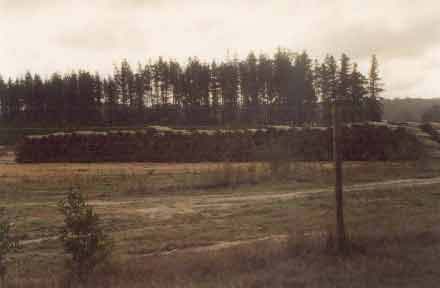
Treated pine at treated timber plant at Beaufort - Central West Victoria
PROBLEMS WITH THE FIXATION PROCESS
Copper Chrome Arsenic salts come in a soluble form, are dissolved in water, and then pressured into partly dry timber (empty cells, wet cell walls). The CCA is fairly acid and the timber less so and this leads to a chemical reaction in which the chrome reacts with the Cu and As to convert them into insoluble salts which are fixed in the timber and will not wash out.
BUT this fixation takes some 2 to 3 weeks at 20 C and double that at 13 C . It will also vary according to the pH of the wood - which does vary. During this time if the timber is exposed to the weather and starts drying, salts will come to the surface ready to be washed off by rain. That means that the freshly treated timber should be kept wrapped up or at least, out of the weather, until the salts are fixed.
The fixation process is specified in the Australian Standard AS 1604 - Timber Preservative treated - Sawn and Round.
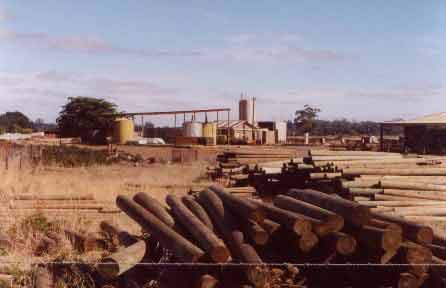
Treated pine facility at Bungaree - Central West Victoria. Note CCA timber stacked in open.
If treated batches of CCA treated timber are repeatedly stored in the same place exposed to the weather, it follows that over a period of time - several years - the ground under will get heavily contaminated with Cu, Cr and As. This happened at a treatment plant in NSW and the local Council permitted the land to be rezoned for housing when the plant packed up. This was later discovered and the housing had to go as the ground was dangerous.
Authorities have had to clear old CCA treatment sites costing several times the value of the land. Naturally this could vary widely. This means that such a site would have no capital value - much the reverse - and that it should not be acceptable as security by banks for overdrafts etc. and it should appear in their balance sheet as liability not an asset ! Soil contamination at sites storing CCA timber, such as Timber Yards can also occur.
The following soil sample was passed onto Friends of the Earth in November 2002. The site was a timber yard at Port Melbourne, which did not treat the timber on site - only stored timber on site. These figures reveal that timber yards selling CCA treated timber may also have problems with leaching chemicals into their timber yards, raising a host of environmental issues relating to the safety of timber yards.
4 Nov 2002: STATE CHEMISTRY LABORATORY - SOIL TEST RESULTS
| Sample No. | Description |
Total As Arsenic mg/kg |
Total Cu Copper mg/kg |
Total Cr Chromium mg/kg |
Sampled |
| A16923/02 | SOIL SAMPLE | 79 | 140 | 160 |
-
|

CCA treated pine boardwalk, Corner Inlet, Victoria.
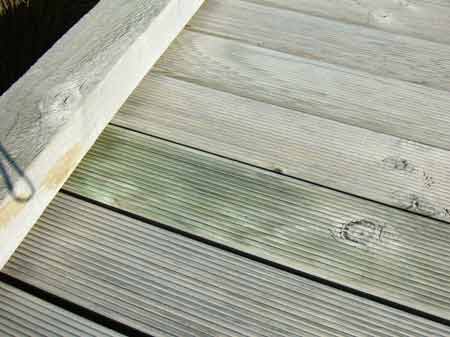
Same boardwalk. Corner Inlet. Note green tinge of CCA timber. CCA pine fades to a grey colour over time as it becomes more toxic
The following explantation reveals a major weakness in the treatment technology pushed by the CCA treatment companies.
Most sapwood can be penetrated with CCA but very often heartwood which can be properly penetrated. The results of this can be seen on the top of round treated fence posts which have been "capped" or cut off to line up with the top of the fence. After a few years these will have a rotten centre. The Standard - AS 1604 is misleading in this point.
Another example of this problem is acoustic barriers along the freeways. They ofetn consist of badly treated boards which won’t show much signs of decay as they are above ground, except at the ends. The ends of the poles is where to look. These pine poles, especially the big square ones, have in most cases, been cut off to line up with the top of the boards. If you see some new ones going up and pick up one of the cut off caps, you will see the penetration pattern on the discard. There will be a thin surround of CCA on the sides and a bit more depth of penetration in the original TOP end. This means that most of the remaining exposed cut end of the post is untreated and unprotected from the weather and therefore will decay - like those topped fence posts - only more so.
When the decay moves down inside from the top and there is a gale, the top boards may blow off. One has to wonder how viable these treated posts will be in the long term. They may well be unusable in 5-10 years - leading to more disposal problems. The reason that this is not covered by regulation is that the CSIRO participates in joint industry projects and this has possibly compromised the standards board (Standard - AS 1604) which contains many CSIRO scientists. Which in turn suits the multinational Koppers-Arch and Osmose who produce CCA.
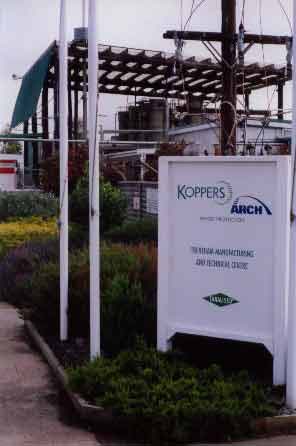
Koppers Arch treatment facility at Trentham (Victoria).
Current production of CCA in Australia is about 750,000 cubic metres p.a. Annual usage of CCA/ACQ in Australia is about 8000t. LOSP's 650 t and HTC/PEC 5000t.
(see http://www.australiaforest.com/articles/feb2002/world.html).
In Australia, creosote and copper chrome arsenic (CCA) treatment plants were established in the 1950s, mainly to protect eucalypt telegraph and power poles. Since that time, the industry has expanded so that now Australia is the third highest user of treated wood per capita.
Currently in Australia that are about 130 CCA plants, 35 boron plants and baths, 11 light organic solvent preservative (LOSP) plants, 4 creosote plants, 2 ammoniacal copper quaternary ammonium (ACQ) plants and one furnace oil plant for railway sleepers. http://www.mountgambier.sa.gov.au/aboutcouncil/agendas_meetings/env/2001/november/mins_13_nov.htm
A recent Sinclair Knight Mertz review for SA EPA shows that present volumes (perhaps a few thousand tonnes/pa) of CCA timber to the waste stream will balloon out to 160,000/pa in SA alone by 2030-2040. The curve is exponential - and they admit that current landfills are completely inadequate and some are in catchment areas. http://www.environment.sa.gov.au/epa/pdfs/timber.pdf
Looking at all treatment types (CCA, LOSP etc), annual total production of treated timber in Australia is in the region of 20 - 30% of the total domestic consumption of 3 million cubic metres of softwood.
It is not only softwoods that are being treated with CCA - hardwoods have been increasingly treated also - especially in Queensland. There are a number of alternatives on the marketplace, and even those available in Australia - Tanalith E and ACQ - are significantly better than CCA. But they are still, of course, a long way from being 'sustainable', and remain a stop-gap for better technologies/ natural durable timbers grown in a sustainable context.. Current plans to dispose of this waste include high temperature waste incinerators.
We remain skeptical of the long term success of such schemes (see below). We argue that it would be far better to not produce the substance in the first place. We have concerns about the containment of the ash and soot from the incinerated timber.
“Study to research treatment of waste wood stockpiles. 7/01/2002.
Study to research treatment of waste wood stockpiles. Research into the potential to recover copper, chromium and arsenic from Australia's growing stockpile of treated waste wood is expected to attract international interest.
The $600,000 study will be funded the University of Sydney, the Forestry and Wood Products Research and Development Corporation, and South East timber company Auspine, which is looking to burn the waste in a proposed biomass power plant.
It is estimated that 1 million cubic metres of broken vineyard trellis posts and other products are currently stockpiled in Australia ready for disposal.” http://abc.net.au/news/newsitems/s453561.htm
According to CCA researchers in Canada (deborahbarrie@hotmail.com); “the burning of cca wood leaves about 80% of the metals in the ash, the remaining 20% are released in the smoke. One 12 foot long 2 by 6 has enough arsenic to kill 250 people so 20% released in the smoke is very dangerous. One tablespoon of ash can kill a 250 lb person.”
Another problem is the possibility of the release of Arsine Gas as a by-product of the landfilling CCA Treated Timber.
From an email sent by an American researcher to the same source as above: “As you are aware if Arsenic is subjected to a reduction process it will produce arsine gas. This is the case where CCA treated wood is stored in landfills where the environment is a reducing (anaerobic) environment. This will cause the arsenic in the wood (which there is plenty of it i.e. between 3000 to 9000 ppm) to produce arsine gas which is often vented to the air or flared. This is in addition to the leaching of arsenic into the ground water and surface water.
As you are aware, despite the fact that cca wood fails the TCLP test, it is not regarded as hazardous waste by the EPA. Therefore it could be disposed of in unlined landfills. You may as well put 144000 lbs. of (amount of arsenic used in Florida alone in 1996) arsenic in the aquifer. This amount is capable of contaminating Lake Michigan to levels above 10ppb.”
CCA waste in Melbourne is definitely being landfilled into normal 'unprotected' landfills around the city. There is a review on whether this waste should be upgraded, but the review won't be completed until mid 2003.
We have grave concerns over the current potential of arsenic pollution from existing landfills in the Port Phillip Bay Catchment and other landfills scattered throughout the countryside. Municipal tips are the source of dumped CCA treated pine throughout Australia.
We would imagine that standards in these landfills would vary across the country and we would estimate that very little protection to underground water supplies in many areas would be granted from arsenic and chromium pollution associated with CCA Timber. Alot of CCA treated pine waste is transported to Adelaide from Mount Gambier and then stored at United Transport's Dry Creek Dangerous Goods storage facility then treated via a fixation process and then sent to land fill. This is an unsustainable outcome.
Australia will soon be producing about 750,000 cubic metres of treated timber a year, most of it for use in vineyards. The Australian Wine Industry must therefore take full responsibility for the quantity of the pine posts used in their vineyards.
We recommend that the Australian Wine Industry immediately start an implementation plan aimed at;
a) reducing their demand for CCA timber,
b) looking at alternative sources of poles in plantations
c) Investigate and implement plans to shift current production of CCA to alternatives such as ACQ.
There may also be already a million cubic metres of broken trellis posts and other waste stockpiled on farms and vineyards for disposal. The South Australian Wine and Brandy Association are the largest users of treated timber in Australia. What contingency plans are there for the safe disposal of these posts? www.environment.sa.gov.au/epa/pdfs/timber.pdf
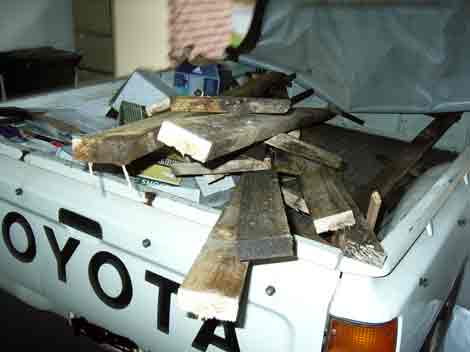
January 2005: CCA pine ready to be disposed of in Melbourne.

January 2005: CCA pine dumped in Nunawading Transfer Station. Ready for landfill. How much treated pine is dumped in Melbourne each year?
CURRENT APPLICATIONS OF CCA TIMBER
DECKING
Australia produces almost 50,000 cubic metres of timber each year for decking. Approximately, two thirds of Australian houses have a hardwood deck. About 35.5% of decks are made using treated pine.
We have major concerns about houses using CCA pine as a construction material and a decking material. It would appear that significant risks would be associated with the decking, as bare feet are exposed to CCA, children playing on the decking could be exposed to arsenic ingestion if they put their hands in their mouths after playing or walking on the decking. Babies crawling on treated pine decking are another major risk factor.
We also have concerns about decking surrounding jacuzi’s and swimming pools where water may be treated with chlorine. At this stage we are unsure about the possibility of chemistry of chlorine and arsenic/chromium combinations.
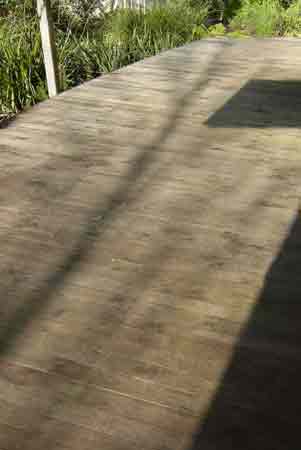
PLAYGROUNDS
We believe that children are being put in a position of inherent risk if they are exposed to arsenic on play equipment made out of treated pine. This concern was recently highlighted this problem in the Diamond Valley Leader and the issue has been promoted through Friends of the Earth’s website: http://www.melbourne.foe.org.au/pr/2003/030110.htm This playground has now been removed by Greensborough Primary School and the school needs to be congratulated for the removal. Also see the following website for results of swipe tests conducted by Croydon Conservation Society which proved that CCA is leaching from playgrounds in their area. Click here for further details.
It would appear that there are still numerous playgrounds in the Melbourne region that have been constructed with CCA. Many of these playgrounds remain in Primary and Secondary Schools. It would appear the Education Department in Victoria could be at risk of litigation by continuing to allow children to play on potentially toxic playgrounds. Local councils also have responsibility over local playgrounds.
We have observed parents letting their babies crawl along treated pine boardwalks at these parks, oblivious to the fact that leaching of CCA pine can and does occur. Some of the playgrounds were built by local communities working in association with the company Leathers. We are still waiting on Leathers to announce a similar statement in Australia as the media release below;
“One of the nation's leading wooden playground design firms, Leathers & Associates, said it will no longer build playgrounds from arsenic-treated wood.
Instead, the firm will use wood infused with either a boron compound or a compound called ACQ.
Leathers & Associates has helped volunteers build some 1,600 playgrounds around the United States, including at least five in west-central Florida.
In March, the Times commissioned soil tests at all five playgrounds and found arsenic at levels higher than the state allows when it requires polluters to clean up neighborhoods.
The fanciful Leathers playgrounds are designed by children and built by thousands of community volunteers. Leathers & Associates builds about 70 to 80 playgrounds around the country each year.”
BEDS
Some furniture companies in Victoria making beds out of CCA pine. This would appear to put the user of the bed at risk of arsenic exposure - especially if bunks are being made! This type of CCA application must be stopped.
FENCES
Almost all fence applications in Melbourne are now made with treated CCA pine.
OUTDOOR FURNITURE
We have also researched issues relating to outdoor furniture made from CCA including park benches and tables. Are people sitting at a CCA treated pine table in a park somewhere being told that they could be putting their health at risk by placing food directly on the treated pine - or that their childrens’ hands are coming into contact with wood that has been impregnated with arsenic? What is the potential liability of local government and state government authorities in these situations? .
ORGANIC GARDENS
Gardeners have unknowingly stored their produce in cca wood chips or sawdust or lined their garden beds with CCA pine.
OUTDOOR APPLICATIONS
In many places treated pine posts and rails are used as barriers for carparks. In one carpark in Wagga Wagga, we observed that the treated pine posts were seen to be falling apart due to rot. Splinters and wood dust were observed lieing in small heaps on the ground. In a heavy wind it may be possible that people could inhale wood dust blown from crumbling CCA infrastructure.
At Uluru, we observed that many people use the treated pine posts and rails at the National Park for viewing access of Uluru. Many of the posts and rails were splintering and many children were observed crawling over the posts and rails. The potential of arsenic poisoning from thousands of locations where treated pine posts and rails are used could be enourmous.
FIRE RISKS
We have also noticed that treated pine posts are often used in campfires throughout many locations in Victoria. At one particular campsite in the Acheron River catchment, it was evident that a complete pole had been burnt, with the associated ash laying in the fire heath waiting for a gust of wind to blow the ash into a nearby river and surrounding campsite. How many campsites throughout Australia have been potentially contaminated through the burning of CCA treated poles and how many people remain ignorant about the dangers of burning treated pine in fire places and inhaling the smoke fumes?
We have just heard of reports of a treated pine playground that was recently burnt to the ground by vandals in the Melbourne suburb of Hampton. What happened to the smoke plume from this fire? Not only would it be possible that the vandals inhaled arsenic contaminated smoke, but there is every chance that nearby residents may also have inhaled this smoke as they slept.
The burning of houses containing CCA products would also cause problems for firefighters and residents alike. One only has to guess at the potential risks of associated arsenic poisoning that the residents of Canberra recently experienced when bushfires cut through suburbs in that city. Weremember a scene on the television news where a resident was desperately attempting to put out a fire at the back of their house that had recently started burning their treated pine trellis and fence.
HEALTH WARNINGS
Throughout Australia, when Treated Timber is purchased by a customer at a store are any health warnings given to purchaser re: handling, sawing etc of CCA?
We feel that not enough information is being directed towards consumers regarding the dangers of CCA products. We believe that many companies selling these products could be opening up a potential pandora’s box of litigation. And this information is certainly not available to people who may come into contact with CCA timber after it is used in the environment. Most people would be blissfully unaware of the potential dangers of this product, as no warning signs are ever granted at picnic grounds etc.
PLYWOOD
There is quite a large CCA plywood industry and we have as yet found little information pertaining to health risks of working with and using CCA treated plywood. One of the largest manufacturers of CCA treated radiata pine plywood is Carter Holt Harvey, whose Material Safety Data Sheet for the product outlines Health Effects. Our concern here is that are the safety warnings visibly displayed at all of the outlets where this product is being sold?
HOUSES AND CABINS
We oppose the construction of log cabins and children’s playhouses made from CCA timber. It would appear that this application could provide all sorts of opportunities for arsenic poisoning.
CHILDRENS PLAY SETS
We have also recently been alerted to the fact that children’s wooden building blocks used in playsets could also be treated with CCA. We oppose this type of application.
Also the following link has some explicit information concerning government officials in South Australia who allowed excess CCA solution to be dumped into puddles on the sides of roads!!!
http://www.sa.democrats.org.au/parlt/budget99/0707_1.htm
Another issue here is, at some CCA treatment plants that we have looked at, there appears to be little contingency for transport issues, particularly the risk of CCA solution finding its way onto truck or vehicle tyres at the treatment plant. This problem could see CCA solution spreading well beyond the actual treatment facility. Some treatment facilities have resolved this issue, but many others have not. Many treatment plants are in very poor shape with lax environmental controls. One particular treatment plant at Ballan was a real worry, with a whole timber yard of CCA pine sitting out in a paddock.
Freshly treated pine was also sitting out in the open air and environmental safeguards appeared almost non-existent. The following information comes from Canada - deborahbarrie@hotmail.com
Treated pine (Copper Chrome Arsenate) sitting in timber yard at Portland Pine Products Pty Ltd near the south west Victorian town of Heywood - probably leaching arsenic, copper and chromium into soil and possibly groundwater.

Portland Pine Products produces treated pine posts and poles for rural fencing, vineyards and orchard latticing and landscaping.

Treated CCA pine jetty. Bare feet, splinters etc
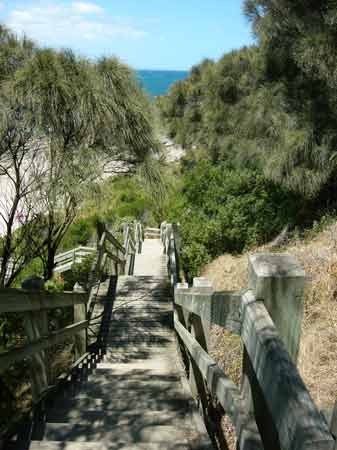
Treated CCA pine staircase to beach in Gippsland. Barefeet, cuts on feet could see arsenic enter body.
Green Triangle Forest Products

Mount Gambier's famous Blue Lake. Pollution from a myriad of sources, including timber treatment plants, could reach underground aquifers which connect up with the Blue Lake which incidently provides Mount Gambier with drinking water. A major CCA spill occurred in Mount Gambier in 1995, where 40,000 litres of CCA leached into the ground. The mill at the time was operated by the company CSR. Toxic plumes of CCA solution have been recorded under Mount Gambier treated pine sawmills.
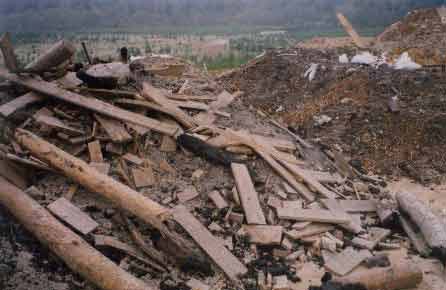
Dartmoor - Victoria. Softwood offcuts and the like, dumped and burnt. What is the destination of treated pine offcuts and sawdust. Is the waste dumped in places like this where the heavy metals will leach into groundwater. Is it burnt in open aired pits where workers and downwind residents (and animals) can breathe the polluted smoke in?
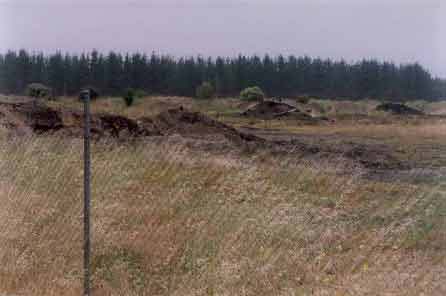
Dartmoor - Victoria. Inside the GTFP timber mill. Are these piles of sawdust contaminated with CCA? GTFP is now owned by the notorious forest company Weyerhaeuser.
Auspine (taken over by Gunns Ltd August 2007)
Auspine (Gunns) is a leading supplier of construction timber to the domestic housing market. The company is a major supplier of fencing and trellising products to the viticultural industry. Auspine (Gunns) is also one of Australia's major sources of imported timber products.
Auspine (Gunns)make treated pine microline beams, framing, sawn fencing timbers, palings, pickets, and rounds.
Excellent link to information about Auspine here
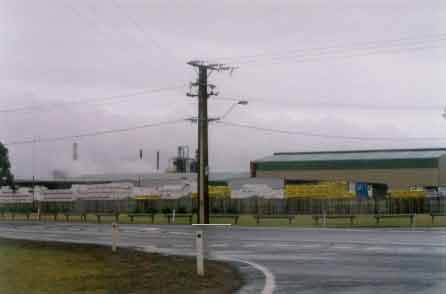
Auspine's (Gunns)Tarpeena sawmill located in south eastern South Australia. Australia's largest treated pine facility is based in the nearby town of Kalangadoo. Auspine also have a treatment plant atScottsdale in north east Tasmania.
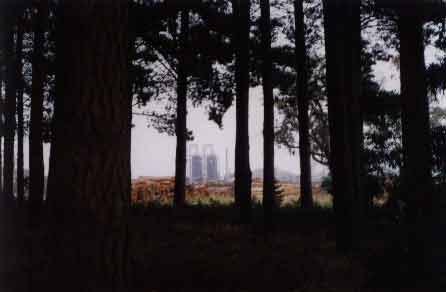
Auspine's (Gunns)Tarpeena sawmill has pine plantations surrounding the northern most portion of the mill.
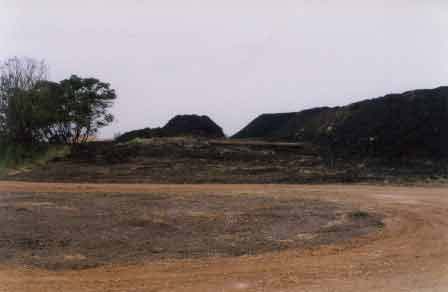
Auspine's (Gunns)sawdust piles. One hopes that sawdust from the CCA production does not make its way into sawdust piles used for compost and garden mulch.

Auspine (Gunns) also sell hardwood native forest timbers from Western Australia. In this case Jarrah.
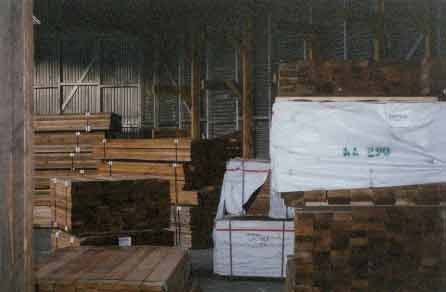
Part of Auspine's stash of imported rainforest timber.
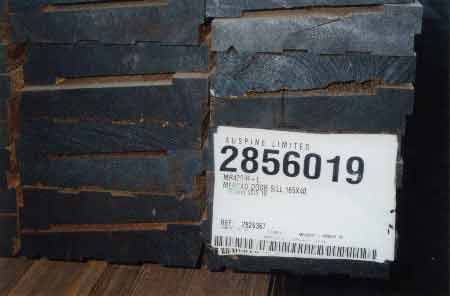
Merbau - imported by Auspine and probably sourced from old growth tropical rainforests in Malaysia.
Suppliers of ACQ - Ammonical Copper Quad
We are still compiling this list and are assessing the environmental issues surrounding the use of ACQ.
Warning: According to the Australian Pesticides and Veterinary Medicines Authority (APVMA), the only registered ACQ timber treatment available in Australia is registered to Osmose. ACQ is regarded as a Schedule 6 Poison. According to the APVMA website, the constituents of ACQ are; 272.399 g/L Copper Ammonium Carbonate and 56.400 g/L Didecyl Dimethyl Ammonium Chloride (DDAC). According the the Pesticides Action Network DDAC is listed as being toxic. see here.
Arsenic arrives in 'toxic trade'
The United States is the world's No. 1 arsenic consumer, and China provides most of it.
By JULIE HAUSERMAN, Times Staff Writer © St. Petersburg Times published December 29, 2001 TALLAHASSEE -- Decks and playgrounds made of pressure-treated wood, as common in Florida as backyard barbecues, rely on an imported poison that generally comes from only one source. China. The United States is now the largest consumer of arsenic in the world, government documents show, and China is America's biggest supplier. Ninety percent of imported arsenic goes into pressure-treated lumber.
In China, the arsenic is an unwanted byproduct of mineral production. By the time it gets to the United States, though, it's considered an industrial ingredient. Wood treatment companies use the potent chemical in a pesticide to deter bugs and weather.
Now, the arsenic is leaking out of wooden decks and playgrounds, polluting soil in Florida and elsewhere. Government researchers are studying how much risk the arsenic pollution poses to people and the environment. Some communities have closed or replaced playgrounds made with arsenic-treated wood. The U.S. Consumer Product Safety Commission is considering a petition by environmentalists to ban the wood.
America once produced its own arsenic, but the last facility in the U.S. closed down in 1985 after government regulators found widespread pollution. The Tacoma, Wash., plant is now a Superfund cleanup site. Since then, China has stepped in to fill America's demand.
In copper smelters, Chinese workers load rocks into hot chambers. As the rocks cook, they release poisonous arsenic gas. When the smelters cool, the arsenic gas turns to powder. Chinese mine workers go into the chambers and scrape the powder into piles. To America's $4-billion-a-year treated wood industry, this cheap arsenic -- about 35 cents a pound or less -- is a key ingredient in their most popular product. Wood treatment companies use the arsenic in chromated copper arsenate, or CCA, a pesticide that is infused into the boards.
Environmental and human rights advocates say this Chinese arsenic is part of a "toxic trade" that uses inexpensive labor and dangerous ingredients when more benign, but often more expensive, chemicals would do the job. "It's not far-fetched to say that the desire for decks in our back yard and wooden playgrounds is driving this international toxic trade," said Bill Walker, a spokesman for the Environmental Working Group, a national group that's working to ban arsenic-treated lumber. "It's an example of how American consumers are getting products pushed on them, and they don't really know they are at the end of a long chain that's causing problems halfway around the world."
Walker said the pressure-treated wood industry doesn't have to use arsenic. The American companies that make lumber treated with arsenic make another kind of pressure-treated lumber, one that's arsenic-free. They sell it mostly overseas, in countries where arsenic-treated wood is banned. Switzerland, Vietnam and Indonesia have banned arsenic-treated wood. Japan, Denmark, Sweden, Germany, Australia and New Zealand have either restricted it or proposed restrictions. Arsenic-free treated wood is not readily available to U.S. consumers.
And for wood treaters to make the kind they sell in America, they need arsenic from abroad. Three major U.S. companies import arsenic, according to the U.S. Geological Survey: Chemical Specialties Inc. of Charlotte, N.C.; Osmose Wood Preserving Inc. of Buffalo, N.Y.; and Arch Wood Chemicals Inc. of Norwalk, Conn. The United States imported 34,000 metric tons of arsenic compounds in 2000, according to the USGS. Some of it came from Chile, but most came from China.
Spokesmen for all three wood-treatment companies refused to comment on the imported Chinese arsenic. Dave Fowley, spokesman for Chemical Specialties Inc., said his company considers it "proprietary information." Human rights advocates in this country say it's tough to get details on arsenic production in China. But they say information is leaking out about Chinese workers in chemical factories and mines, and it's not good.
"Health and safety conditions are abysmal," said Ken Zinn, North American regional coordinator for the International Federation of Chemical, Energy, Mine and General Worker's Unions. About two years ago, Florida's Department of Environmental Protection in Tallahassee received an anonymous envelope in the mail. Inside there were pictures of Chinese workers, some without even rudimentary masks, standing beside huge piles of white powder. The pictures were carefully labeled, identifying the powder as arsenic trioxide. The pictures arrived as the DEP was beginning to talk to the wood-treatment industry about a new garbage problem for Florida: arsenic leaking out of old pressure-treated wood in unlined dumps. "There was no business card and no letter," said Bill Hinkley, who heads the DEP's division of solid and hazardous waste. "The pictures were labeled. I don't know who labeled them. We had no way of verifying what the pictures were, and DEP has no jurisdiction over worker impacts." Zachary Mann, a U.S. Customs spokesman in Miami, said that trying to trace any product back to its Chinese source can take years, and the facts may still be muddled. It's also hard to tell what impact the arsenic trade may be having on China's environment.
The evidence is clearer around Tacoma. ASARCO, the last domestic arsenic producer, left a legacy of pollution in the town and in Commencement Bay. Bulldozers have descended on neighborhoods, digging up 1,000 arsenic-laced yards so far. It will take years and millions of dollars before the cleanup is finished, an ASARCO spokesman said.
Flammability of CCA Treated Timber Poles
- The Canberra bushfires in 2003 wiped out 500 timber poles, Ash Wednesday (1983) knocked out 300 poles near Melbourne and the North East Victorian fires of 2003 destroyed about 100 electrical poles). Bushfires in Australia destroy many timber electricity poles each year. The following article explores some of these issues: Source PT&D February/March 2003.
"AFTERGLOW
The following is the personal experience of Chris Pemberton, now with Power and Water Corporation, Darwin.
'Having started my career with the SECV (State Electricity Supply Commission Victoria), which loved creosote, I did not come across CCA treated timber until the 70's when I moved to PNG (Papua New Guinea). The PNG Electricity Commission owned a 66kV line of out Lae made from locally treated Hoop Pine.
During the 70s we lost about 40 poles on this line during grass fires. Although the local grasses are very tall, with little wind the fires were not very hot, and no poles were significantly charred. Failure invariably occurred at one point, starting from a glow point, with the pole smouldering several hours before collapsing.
I learned from the Forestry Department that this phenomena was well known, with the ability of a material to sustain a smouldering state called "afterglow". I was informed that CCA treatment of timber enhanced the afterglow properties of timber, especially softwoods.
In the 90's, I was working for Peel Cunningham CC at Tamworth, and we were looking for replacements for both Tallowwood crossarms and natural round poles. We were offered laminated pine crossarms treated with CCA. Remembering my PNG experience, I researched the subject of afterglow more thoroughly. Sure enough, I found that the phenomena was well documented.
I went so far as to ask one pole chemical manufacturer whether it was possible to add a fire retardant in the mixture. I was told that this was not done because the retardant reduced the effictiveness of the fungicide.
To satisfy ourselves, we set up a treated laminated crossarm in the workshop, and applied a high voltage current between insulator pins. We used fans to ensure a wind velocity of at least 1 m/sec. Sure enough, after ignition, the tallowwood crossarm self-extinguished within a minute or so of removing the current. The treated CCA crossarm kept smouldering until it burned through. We did not purchase treated crossarms.
In the NT (Northern Territory) we only use steel arms, and we compensate for the loss of impulse strength by using larger post insulators. This has been a very successful strategy in terms of reliability. However, this is a more expensive option, and some supply authorities may baulk at the extra cost involved.
Although Australia continues to import a large quantity of timber, every year 20 thousand to 30 thousand hardwood trees are felled from Queensland forests alone to provide poles for the electricity industry.
There are different bushfire intensities and risk levels eg, as defined on the NPWS web site. The worst is "wildfire", and is usually in summer (hot) high wind (oxygen) with high fuel. The CSIRO website defines the fire hazard by the Fire Triangle.
'For a fire to thrive and spread it requires three things: 1. Fuel for the fire to burn. 2. Air for the fire to breathe - enhanced by wind velocity. 3. Heat for the fire to continue burning. Removal of any one of the sides of the Fire Triangle will extinguish the fire'.
In a Paper presented at last EESA Conference in Canberra David Eccles gave further insight into the problem.
'During the dry extreme 40 degree C plus hot dry summer bushfire periods, the electrical network assets are at risk of damage by bushfires. Wood poles and crossarms are combustible given the appropriate levels of heat and oxygen and time to initiate combustion. The heat is usually related initially to proximity of fuel. (A grass fire or canopy fire burning past a wood pole can ignite the wood causing a sustained smoulder or wood pole fire long after the fire front has passed by).
A modern hazard for some CCA-treated wood power poles is a reported relatively enhanced "afterburn"effect, which can help CCA treated poles to continue to burnout long after the fire front passes. The researchers have developed various proprietary CCA adaptions to try to reduce the afterburn effect of CCA'.
CREOSOTE TREATMENT
The creosote treated poles tend to have less afterburn. This afterburn problem if its applicable, is best remedied by prompt site access to line patrol and to put out pole fires after the fire passes by, or prior removal of nearby vegetation fuel, or the use of non-wood poles such as concrete/steel hybrid combinations (e.g. Stobie pole of South Australia). Steel Nailed wood poles or concrete/steel/wood hybrids are still combustible in the wood component.
LONG AERIAL CONDUCTORS
Of greater risk significance are the conductors - the loss of long aerial conductor spans by bushfire burning-out their pole supports, viz wood crossarm or wood pole burn-out, can mean a long delay to restoration of electricity supply of several weeks if on rural radial systems without access to distributed or mobile step-up generation. Bare aerial conductor damage by observation, is normally minimal unless the aerial conductor is left close to sustained fuel, such as fallen on/near the ground for some time.
SUSTAINABLE DEVELOPMENT
The issue of sustainable development needs some investigation. Timber poles have a variable life expectancy of approximately 20 -30 years (some "regal" timbers will last longer, but they are in short supply, and the more common lower quality timbers need chemical treatement to be of service). The time period required to replace these trees exceeds their life span as a timber pole, which is not consistent with the theory of sustainable development. As a direct result of this shortage, the electricity industry is now using timber of lesser quality than was previously used twenty years ago and consequently their life expectancy has been reduced, even though chemical treatment of timber is now widespread.
While some authorities are advocating the use of pine as a future alternative, research indicates that they are not a realistic option due to its low structural strength and lack of durability in tropical and sub-tropical climates.
Every tree felled only supplies a straight pole a proportion of its height. The rest is burnt or chipped. This is an unacceptable waste of a natural product when suitable man-made alternatives are available.
CHEMICAL IMPREGNATION
To extend the life of timber poles they are impregnated with a variety of chemicals, commonly and typically copper-chrome-arsenic, or pigment emulsified creosote formulations.
In a report by the Murrumbidgee County Council on the chemical treatment of timber poles, to counteract rot and insect attack, and the associated costs, it was stated "the chemicals which are the most effective in their control are also the most toxic and environmentally unacceptable". Chemicals are used to extend the timber pole's life expectancy and resistance to biological and termite hazards. However, in its report the Council stated that "the use of chemicals does not prevent pole failures in the long term, as eventually all timber poles will fail" due to their susceptibility to weather and biological hazards (rotting, fire, termites etc). The Council raised the question that "if the application of chemicals is necessary and effective then why is the industry still changing 30,000 poles per annum?"
While it is commonly accepted that ground rot is a common form of physical failure, pole top failure in timber poles has also been a concern as linesmen have been seriously injured working on timber poles that have snapped.
Unions are critical of the potential danger their workers are being exposed to when handling treated poles in the field and have lobbied for alternatives to use in the future.
Difficulties with CCA poles have arisen when the poles were not adequately seasoned prior to impregnation. Under these circumstances there has been inadequate penetration of the sapwood by the CCA salts and cracking of the pole sapwood after erection allowing access to fungus or termites to the unprotected heartwood. CCA salts make the timber pole more conductive, which makes the pole more conducive to pole top fires. Although considered to be "non-conductive" there have been a number of cases of severe shocks from "live" timber poles, when the poles are saturated.
Electricity Companies guard against this potential by either adopting a "safety approach" procedure using a Modiewark Tester, or by inserting a coach screw into the timber pole and conducting a leakage test prior to working on the pole.
TOXIC WASTE
Working on CCA treated poles that have been damaged by fire presents particular problems. The following information was obtained from a "safe working practices" document, "Working With CCA Poles". Workers are recommended to use full protective clothing in addition to normal safety equipment, if there is a danger of ash being dislodged.
After removal of the burnt pole material and re-treating of the section, the ash must be disposed of to a controlled landfill. All equipment should be washed, and all traces of ash removed. Any soil that is suspected of being contaminated with CCA pole ash is to be disposed of at an approved landfill.
Disposal of old treated poles will be a continuing problem due to the presence of arsenic. The pole will need to be treated as a toxic waste. It cannot be sold for firewood as the ash is considered a toxic material.
CCA treatment is banned in a number of countries, most recently in Japan...."
"In Australia a recent study reported indicated Waste CCA-treated lumber should never be burnt. This study featured in Sept. 15, 2003 Environmental Science and Technology found that burning this wood not only releases arsenic into the air, but also creates copious amounts of dioxin, another human carcinogen. The chemistry of the dioxin formulation isn't clear, but the experiments showed that PCDD/F toxic equivalent of (TEQ) levels of 35ng/kg from bottom ash Tame et al 2003." - From submission to APVMA from Warren Godson Feb 2004.
Increased PCDD/F formation in the bottom ash from fires of CCA-treated wood.
(Published in Chemosphere)
N.W. Tame, E.M. Kennedy, B.Z. Dlugogorski cgbzd@alinga.newcastle.edu.au
Process Safety and Environment Protection Group, School of Engineering, The University of Newcastle, Callaghan, NSW, 2308, Australia.
Received 6 June 2002; revised 3 October 2002; accepted 1 November 2002.
Abstract
Bottom ash that was the result of the combustion of chromated copper arsenate (CCA) treated wood under controlled fire conditions showed an increase of several orders of magnitude in the levels of polychlorinated dibenzo-p-dioxins and dibenzofurans (PCDD/Fs), compared to that of untreated timber. Wood that has been pressure treated with CCA contains copper (II), which is known to catalyse the so-called de novo formation of PCDD/Fs. Comparable levels of PCDD/Fs would be expected in residual ash from burning CCA-treated wood in backyard fires, stoves and wood heaters, as a consequence of similar combustion conditions.
1. Introduction
Since the introduction of bans on the use of creosote and pentachlorophenol, chromated copper arsenate (CCA) has emerged as the most popular form of wood treatment. In recent years, the amount of CCA-treated wood becoming waste has increased significantly, highlighting the need for a suitable method of disposal, such as combustion for energy recovery. Traditionally, research into the levels of toxic pollutants from the combustion of CCA-treated wood (Terkildsen, 1996; Solo-Gabriele et al., 2002) has focussed on the emissions of heavy metals, especially arsenic. No thorough investigation concerning the effect of CCA on the production of toxic organics such as polychlorinated dibenzo-p-dioxins and polychlorinated dibenzofurans has been conducted. These compounds are considered highly toxic due to their carcinogenic properties. The toxicity of PCDD/Fs is usually expressed as toxic equivalents (TEQ), where each dioxin is given a toxicity factor (TEF) relative to 2,3,7,8-tetrachlorobenzo-dioxin, which is set as unity. The actual amount of each 2,3,7,8 congener is then multiplied by the TEF and the results are added to yield TEQ.
Typically, the CCA treatment solution is based on salts of chrome, arsenic and copper, the latter of which is of particular interest in the study of the formation of PCDD/Fs. Investigations by Gullet and Bruce (1992), Froese and Hutzinger (1996) and Lenoir et al. (2001) have shown that copper (II) oxide acts as a catalyst in at least one step of the de novo pathway for dioxin formation from the macromolecular carbon source. To form complete and accurate inventories of PCDD/Fs emitted to the atmosphere, most literature studying sources of dioxin formation have concentrated on the emissions of PCDD/Fs on fly ash and in the gas phase. Especially, a large body of work has been conducted on emissions of PCDD/Fs from incinerators. While some groups, Wunderli et al. (2000), Someshwar (1996) and Oehme and Muller (1995), have reported varying levels of PCDD/Fs in bottom ash from both native and waste woods, the effect of CCA-treated wood was omitted. Presumably this was because ash samples were collected from large-scale combustion systems where the associated release of heavy metals caused concern.
2. Experimental
Untreated radiata pine was used as the blank. For the CCA-treated wood, a single piece of radiata pine, treated to the level required for outside, in-ground use, was selected. Both samples were shredded and the metal content (Cu, Cr and As) was quantified using ICP-OES after acid/peroxide digestion. The untreated pine was found to contain Cu, Cr and As levels below the detection limits (<0.5 ppm for Cu, Cr and <50 ppm for As), while the CCA-treated pine contained 4035, 2332, 3038 ppm of Cr, Cu and As, respectively. Before firing, wood samples were dried under nitrogen as 105 C until a constant mass was achieved. A cone calorimeter, was used to simulate the combustion of wood under fire conditions. Samples of approximately 60 g were placed in a stainless steel sample holder with depth of 40 mm and surface area of 0.0088 m2 and were exposed to a heat flux of 50k W/m2. After cessation of flaming combustion, usually within 15 min of ignition, samples were left to smoulder under ambient conditions until cooled. A modified sample holder fitted with thermocouples allowed temperatures to be monitored during each experiment at various depths in sample. Ash samples were retained and analysed for PCDD/Fs using analytical procedures based upon US EPA methods 1613 and 8280.
3. Results and Discussion
Untreated pine ash samples collected during the current experiments exhibit low levels of PCDD/Fs, with an average of 0.050 ng TEQ/kg ash on a toxic equivalent basis (I-TEQ). These results are lower than the values quoted in literature for wood (4.9 ng TEQ/kg, Wunderli et al., 2000, 1.0 ng TEQ/kg, someshwar, 1996 and 0.23-1.12 ng TEQ/kg, Oehme and Muller, 1995). The results depend heavily on factors such as wood type, wood contaminants and post-flaming combustion conditions (carbon burn-out). For the CCA-treated pine, burnt under identical conditions, a significant increase in the amount of PCDD/Fs present was observed, with the total average TEQ for the experiments found to be 35 ng TEQ?kg. The increase in amounts can also be represented by using a distribution of the 17 toxic PCDD/F congeners, where the profile for CCA ash samples is dominated by 2,3,7,8-tetrachlorobenzofuran (TCDF). As the samples were left to smoulder under ambient conditions, the temperature in the ash, having reached an average temperature of 500 C, remained within the temperature windown for the de novo synthesis, that is 250-400 C (Gullet and Bruce, 1992), for approximately 20 min. It is proposed that the CCA, retained in smouldering samples, facilitated this pathway.
4. Conclusions
The uncontrolled combustion of CCA-treated wood waste in stoves, combustion heaters or even in backyard fires should be avoided as it leads to generation of volatile arsenic compounds and toxic organics in the ash. Results from preliminary experiments provide empirical evidence that heavy metals, principally copper (II), present in wood due to treatment with CCA and remaining in the smouldering material after flaming combustion, act as a catalyst for the formation of PCDD/Fs. Owing to high PCDD/F content of ash from CCA-treated wood, in the ash-disposal process, consideration must be given to PCCD/F, not just to heavy metals. Although TEQ levels are much lower for MSW-I fly ash, they are relatively high for bottom ash, which is a cause for concern if the present ash is to be considered for reuse.
5. Acnowledgements
The researchers would like to acknowledge the continuing support of the Australian Government Analytical Laboratory, and in particular Mr. Nino Piro and the Staff of the Dioxin Analysis Unit.
References
Froese, K.L., Hutzinger, O., 1996. Polychlorinated benzene, phenol, dibenzo-p-dioxin, and dibenzofuran in heterogeneous combustion reactions of acetylene. Environ. Sci. Technol. 30. 998-1008.
Gullet, B.K., Bruce, K.R., 1992. Mechanistic steps in the production of PCDD and PCDF during waste combustion. Chemosphere 25, 1387-1392.
Lenoir, D., Wehremeier, A., Sidhu, S.S., Taylor, P.H., 2001. Formation and inhibition of chloroaromatic micro pollutants formed in incineration processes. Chemosphere 43. 107-114.
Oehme, M., Muller, M.D., 1995. Levels and congener patterns of polychlorinated dibenzo-p-dioxins and dibenzofurans in solid residues from wood fired boilers. Influence of combustion conditions and fuel type. Chemosphere 30. 1527-1539.
Solo-Gabriele, H.M., Townshend, T.G., Messick, B., Calitu, V., 2002. Characteristics of chromated copper arsenate-treated wood ash. J. Haz. Mat. 89 (2-3), 213-232.
Someshwar, A.V., 1996. Wood and combination wood-fired boiler ash characterization. J. Environ. Qual. 25, 962-972.
Terkildsen, L., 1996. Distribution of trace elements measured during co-combustion of MSW and contaminated wood waste. Solid Waste Management: Therm. Treat. Waste to Energy Technol. Proc. Int. Spec. Conf., pp. 441-450.
Wunderlia, S., Zennegg, M., Dolezal, I.S. Gujer, E., Moser, U., Wolfensberger, M., Hasler, P., Noger, D., Studer, C., Karlagansis, G., 2000. Determination of polychlorinated dibenzo-p-dioxins and dibenzofurans in solid wood residues from wood combustion by HRGC/HRMS. Chemosphere 40, 641-649."
Journal of Hazardous Materials B89 (2002) 213-232
Characteristics of chromated copper arsenate-treated wood ash Helena M. Solo-Gabriele a,*, Timothy G. Townsend b, Brian Messick b, Vandin Calitu a a Department of Civil, Architectural, and Environmental Engineering, University of Miami, Coral Gables, FL 33146-0630, USA b Department of Environmental Engineering Sciences, University of Florida, Gainesville, FL 32611, USA Received 6 January 2001; received in revised form 23 July 2001; accepted 24 July 2001
Abstract
The combustion of recovered wood from construction and demolition waste as biomass fuel is a common practice. When chromated copper arsenate (CCA)-treated wood is present as part of the wood fuel mix, concentrations of arsenic, chromium, and copper become elevated in the ash. The objectives of this study were to estimate the fraction of CCA-treated wood needed to cause the ash to fail regulatory guidelines and to test a series of solvents for the purpose of extracting the metals from the ash.
Ash samples were prepared in an industrial furnace using samples of CCA-treated wood, mixtures of CCA-treated wood and untreated wood, and recycled wood waste collected at construction and demolition recycling facilities. Regulatory guidelines were evaluated by measuring total metals concentrations (using neutron activation analysis) and by conducting standardized leaching tests (toxicity characteristic leaching procedure (TCLP) and synthetic precipitation leaching procedure (SPLP)) on the ash. Ten different solvents, ranging from distilled water to strong acids, were also tested for their ability to extract metals.
Results of this study indicate that metal concentrations (chromium plus copper plus arsenic) can be as high as 36% of the ash by weight for treated wood samples containing high retention levels (40 kg/m3) of CCA.
All ash samples from the combustion of 100% CCA-treated wood and mixtures containing 5% CCA-treated wood leached enough arsenic (and sometimes chromium) to be characterized as a hazardous waste under US regulations.
Concentrated nitric acid, which was the most effective solvent tested, was capable of removing between 70 and 100% of the copper, between 20 and 60% of the chromium, and 60 and 100% of the arsenic for samples characterized by low retention levels. A particular finding of interest was the efficiency of distilled water and other weak solvents to extract measurable amounts of chromium, especially for ash samples containing low retention levels of CCA. Citric acid was *Corresponding author. Tel.: +1-305-8-284-3489; fax: +1-305-8-284-3492. E-mail address: hmsolo@miami.edu (H.M. Solo-Gabriele). 0304-3894/02/$ - see front matter © 2002 Elsevier Science B.V. All rights reserved. PII: S0304-3894(01)00311-9
Waste Management & Environment ( WME) Vl14#10 November 2003 Extract of Promotion Article by Cleanerway
“Need an Environmental Solution?” pages 52- 53 “- - NSW/ACT
The January 18 bushfires which devastated Canberra and its outlying districts was an event that was not easily forgotten. Four people lost their lives and over 500 homes were destroyed, along with many urban and recreational assets. These assets consist of children’s playgrounds, road barriers, through to camping and picnic areas.
Cleanaway Technical services(CTS) in Newcastle was asked to provide its expertise in the clean up of many of Canberra’s assets. CTS’s primary focus was on the safe removal and disposal of areas affected by Copper Chromium Arsenate (CCA) contamination, resulting from treated timber which was burnt in fires. This project started mid March with 55 sites needing remediation. A program was developed which consisted of the following main points Site assessment. Site excavation. Hazardous assessment of excavated material. Site validation. Appropriate disposal of excavated material. Backfilling of remediated sites. To date almost 2000 tonnes of material has been removed from the affected areas. Eighty percent of the affected sites have been remediated and now open to the public”
s 45. Alleged price fixing 31 July 2006:
The ACCC instituted proceedings in the Federal Court, Sydney, against FCHEM (Aust) Limited, Osmose Australia Pty Ltd and Mr Edward Mark Greenacre, the former managing director of Osmose Australia Pty Ltd, alleging cartel behaviour in the timber preservatives industry, involving price fixing in relation to the supply of various wood preservative chemicals including copper chromium arsenic and light organic solvent preservatives. These products are widely used by the timber industry.
The ACCC is seeking: declarations injunctions, and pecuniary penalties. 7 September 2006: Justice Cowdroy ordered the first and second respondents to file and serve their defences on or before 26 October 2006. This matter is listed to return for a further directions hearing on 2 November 2006.
Osmose fined $1.8 million Friday, 6 October 2006, 4:37 pm
Press Release: Commerce Commission Media Release Issued 6 October 2006/051
Osmose fined $1.8 million in NZ's biggest cartel case Osmose New Zealand, Osmose Australia and two Australian-based executives have been fined for participating in a cartel in New Zealand's wood preservative chemicals industry.
One executive, Mark Greenacre, was fined $100,000, the highest penalty ever imposed in New Zealand on an individual cartel member.
The wood chemicals case is New Zealand's largest cartel prosecution. In both civil and criminal actions, fines totalling over $5 million have been imposed on four companies and three individuals. Proceedings are ongoing against seven further corporate and individual defendants.
The affected part of the wood preservative chemicals industry was worth an estimated $35 million in 2002, and included the iconic "Tanalised" timber brand.
This week the Osmose companies were fined a total of $1.8 million for price-fixing, bid-rigging and attempts to exclude competitor TimTech Chemicals from the market. The fine comprised $1.075 million for price-fixing and $725,000 for the attempted exclusion of TimTech.
Osmose's former General Manager Mark Greenacre was fined $100,000 after he admitted extensive involvement in the cartel. Last month Greenacre pleaded guilty to criminal charges of lying to the Commission's investigators.
Another executive also admitted his personal involvement in the cartel. Colin Newell, Managing Director of Koppers Arch Investments from April 1999 to August 2000, was fined $20,000.
Commerce Commission General Manager Geoff Thorn said that cartels damage the New Zealand economy.
"Cartels raise prices above competitive levels, and harm the companies who buy the cartel's products as inputs for their own business," says Geoff Thorn.
"This cartel made Kiwi farmers pay more for fence posts and homeowners pay more for decking timber, and it also cost companies who treated timber, and companies who used treated timber."
"Cartels don't just cause harm by making their own market uncompetitive, they drag down the performance of other companies who have to pay their inflated prices."
Mr Thorn said the Commission was pleased that the Court was imposing high penalties for cartel behaviour.
"Cartels are hard to find, hard to break and hard to prosecute," said Mr Thorn.
"It is highly preferable to deter cartels from forming and the Commission will continue to seek high, deterrent penalties in cartel cases," said Mr Thorn.
Mr Thorn noted that the penalty imposed by Justice William in the Auckland High Court would have been higher if Osmose, Greenacre and Newell had defended the case all the way to trial.
Background
Mark Greenacre
Greenacre was fined $65,000 for price-fixing and $35,000 for the attempted exclusion of new competitor TimTech. His penalty was discounted because he admitted liability and co-operated with the Commission. Greenacre was General Manager of the Fernz Timber Protection group during 1998-2001, and moved to the same position in February 2001 when the New Zealand business of Fernz was sold to the Osmose chemicals group.
Greenacre was at all times based in Sydney, and continues to live in Australia. His operational responsibilities included the New Zealand businesses of Fernz and Osmose, and from his office in Australia he committed breaches of the Commerce Act that were enforceable by the Commerce Commission in New Zealand.
The Court took into account the fact that Greenacre admitted having lied to the Commerce Commission when interviewed in the course of the Commission's investigation. In September Greenacre was fined $7,000 in the District Court at Auckland for the offence under s103 of the Commerce Act of misleading the Commission.
Colin Newell
A Koppers Arch managing director has now also admitted his personal involvement in the cartel. Colin Robert Newell, Managing Director of Koppers Arch Investments Pty Ltd from April 1999 to August 2000, was fined $20,000 plus costs.
Newell was, and still is, an Australian resident. His conduct occurred six years ago, and took place in the 16 months before he retired. Notwithstanding those factors, the Court held that Newell had 'turned a blind eye' when he was in a senior position and could have stopped Koppers' collusion. Like Greenacre, Newell received a substantial discount for his early admission and co-operation with the Commission.
Wood chemicals cartel
The illegal behaviour occurred between 1998 and 2002 in markets for two wood preservatives, Chrome Copper Arsenate and Light Organic Solvent Preservative. The Commission's investigation opened in May 2002 after a complaint from competitor TimTech. The cartel members agreed to: * share pricing information; * simultaneously raise prices; * not compete on price; * not compete for each other's customers; * attempt to exclude a new entrant, TimTech from the market; and * attempt to eliminate TimTech from the market once it had entered.
April sentencing of Koppers Arch In April 2006 the High Court imposed record penalties on Koppers Arch Wood Protection (NZ) Limited and its Australian parent company, Koppers Arch Investments Pty Limited, after the companies admitted participating in a cartel in the wood preservative chemicals industry between 1998 and 2002. The $3.6 million comprised $2.85 million for price-fixing and $750,000 for attempts to exclude a new entrant competitor from the market.
Cartels
Cartels are groups of businesses or individuals who, instead of competing against each other to offer consumers the best deal, secretly agree to work together and keep prices high. Cartels harm competitors by sharing customers with other cartel members, and by squeezing non-cartel members out of the market. Cartels harm the New Zealand economy by making other businesses pay inflated prices for goods, resulting in more expensive end products that can not compete overseas. An OECD survey has confirmed that the parties to cartel agreements, for the most part, were not honest business people who inadvertently become involved in a technical violation. Rather, they fully realised that their conduct was harmful and unlawful, causing them sometimes to go to great lengths to keep their agreement secret.
Ongoing proceedings
The Commission's case continues against three corporate and four individual defendants and will not comment on the ongoing proceedings. The corporate defendants are Nufarm Ltd (formerly Fernz Corporation), TPL Ltd (formerly Fernz Timber Protection) and FChem (Aust) Ltd.
Previous NZ cartel cases
This is the first significant cartel case to be brought since Parliament doubled the maximum penalties that can be imposed on companies for breaching the Commerce Act's prohibition on cartels. In 2001 the maximum penalty per offence for companies was increased to be the higher of $10 million, three times the commercial gain from the conduct or 10% of turnover. For individuals the maximum penalty is $500,000.
The previous highest company penalty for a Commerce Act offence was $1.5 million imposed on three companies who formed a cartel in the meat industry in 1998. For individuals, the highest previous penalty was a $25,000 fine imposed on eye surgeon Dr Rogers for price-fixing.
Wood preservative chemicals market
Wood preservation of softwoods is a significant domestic and export industry. (Cartel member Koppers Arch is the owner of the well known "Tanalised" Timber brand.) The industry produces a range of products, from poles and fenceposts to house framing and decking timber. The chemicals involved in this proceeding are Chrome Copper Arsenate and Light Organic Solvent Preservative The market for these two chemicals is estimated to have reached around $35 million per annum in 2002.
There are significant downstream export markets of NZ grown and treated timber to Australia and the USA in particular. The Commission also considers that the behaviour will have had an effect on the price paid by consumers for treated timber products.
Criminal prosecutions for hindering investigation
In June 2005 Koppers Arch and its former General Manager Roy Parish pleaded guilty to breaching the Commerce Act by failing to provide documents required under statutory notices. Koppers Arch was fined $25,000 and Roy Parish was fined $8,000. In August 2006 Mark Greenacre for found guilty of lying to the Commission in a voluntary interview. Greenacre was convicted and fined $7,000. In August 2006 Osmose was found guilty of failing to produce documents required by the Commission under statutory notices. The documents included a price-list that Koppers had shared with Osmose. Osmose New Zealand was convicted and fined $13,000.
Leniency and co-operation policies
These proceedings did not result a cartel member coming forward to an enforcement agency, providing admissions and information in exchange for "first through the door" leniency. The Commission's investigation was well advanced before any admissions were forthcoming. The Commission encourages participants in anti-competitive conduct to approach the Commission at an early stage to admit liability. If they sign a Leniency agreement with the Commission they can be immune from Commission prosecution.
Commerce Commission alleges cartel behaviour over CCA companies WEDNESDAY, 27 APRIL 2005
The Commerce Commission says it has filed a civil lawsuit in the High Court at Auckland against four New Zealand timber preservatives companies and seven executives for alleged cartel behaviour.
The commission's allegations centre on sharing prices, price fixing, collusion and bid-rigging by the four companies during a four year period from 1998. The companies are: Koppers Arch Wood Protection (NZ) Ltd; Osmose New Zealand Ltd; TPL Ltd and Nufarm Ltd.
At different times, two of the companies were previously known as Fernz Timber Protection: TPL between 1984 and November 1999, and Nufarm between December 1999 and January 2001.
The commission will not disclose the names of the seven executives until they have appointed lawyers. The commission has also initiated proceedings in Auckland against related Australian-based companies. Koppers Arch in New Zealand is part of a group in Australia, Fiji and Asia and is related to two big companies in the United States – Koppers Inc and Arch Chemicals. The commission says the allegations related to supply of wood preservatives, chemicals and assorted services, including CCA (copper chromium arsenic), light organic solvent preservatives and boron. The products are widely used by the timber and associated industries.
The commission filed criminal charges in February in Manukau District Court against Koppers Arch and its general manager, Roy Parish. They alleged non-compliance with statutory notices issued under the Commerce Act that require production of information and documents to the Commission. The maximum penalty for a breach is a fine of up to $30,000 for a company and up to $10,000 for an individual.
In March, Australian officials ruled that treated pine timber would be phased out for use in play equipment, outside seating and domestic decking by next year and New Zealand's Timber Industry Federation said the decision of Australian regulators to crack down on arsenic residues in treated timber could cost the forestry sector here $50 million.
Timber treated with copper chrome arsenate (CCA), a chemical that prevents rotting, has been linked to bladder and lung cancer in some overseas research. Britain, Canada and the United States have banned its use in recreational items such as play equipment.
Environmental risk assessment of CCA leaching from treated vineyard posts
Vogeler I, Green S, Greven M, Robinson B, van den Dijssel C, Clothier B October 2005
In our experiments at Rarangi, the initial results during the first six months of the experiment indicate that CCA is leaching out of the treated posts. Concentrations in the soils surrounding these posts already exceed, in some cases, the recommended guidelines for chromium (Cr) and arsenic (As) in agricultural soils in the National Environmental Protection Measures (NEPM, 1999) of 100 mg kg-1. In the long-term, the role of As leakage from the post over its lifetime of 20-25 years is critical. The movement of As is 40 times greater out the end-grain of the post’s base, than it is through the wall of the post. The wall, nonetheless, has 20 times the surface area in the soil compared with the end-grain. Some means to limit this endgrain loss locally could be used to develop a sustainable solution. A preliminary calculation suggests that if the end-grain As-flux were zero, say by some form of capping, then the long-term, steady-state As concentration in the leachate would be halved. Further examination is merited.
Recently, a general survey conducted by HortResearch (Robinson et al., 2004) found elevated levels of copper, chromium and arsenic in soils surrounding vineyard posts in the Marlborough Region. Some 25% of the soils that were tested had levels of arsenic or chromium above the National Environmental Protection Measures (NEPM) of the Australian National Environmental Protection Council (ANEPC) guidelines for agricultural soils(100 mg/kg). The study identified that the rate of CCA leaching is affected by the age of the post and the soil type. As expected, older posts tended to have higher CCA concentrations in the surrounding soil. Differences were identified between soil types, but because of the limited number of replicates, it was not possible to relate the degree of CCA leaching with any particular soil property or post age. Soil CCA concentrations decreased beyond a lateral distance of 50 mm and 100 mm beneath the post, but they were still significantly higher than the CCA concentrations in control soils taken from the inter-rows. Some of the measured soil concentrations of arsenic or chromium, below the posts, are above the NEPM guidelines for agricultural soils of 100 mg kg-1. No Cu concentrations exceeded the NEPM guideline value for Cu of 1000 mg kg-1.However, it is likely that soil health is affected at Cu levels above 100 mg kg-1. Further investigations of the impact of CCA levels on soil health could be warranted.
CONCLUSION In the first year of our experiment at Delegats we have observed CCA leaching out of treated posts. Soils surrounding these posts already exceed, in some cases, the recommended guidelines for chromium and arsenic in agricultural soils as set out in the NEPM of the Australian National Environment Protection Council’s “Guidelines on the Investigation Levels for Soil and Groundwater” (1999).
Release of Arsenic to the Environment from CCA-Treated Wood 1. Leaching and Speciation during Service
Environ. Sci. Technol. 2006, 40, 988-993
(Bernie I. Khan, Helena M. Solo-Gabriele, Timothy G. Townshend and Yong Cai)
Insufficent information exists about the speciation of arsenic leaching from in-service chromated copper arsenate (CCA)-treated products and the overall impact to soils and groundwater. To address this issue, two decks were constructed, one from CCA-treated wood and the other from untreated wood. Both decks were placed in the open environment where they were impacted by rainfall. Over a one year period, rainwater runoff from the decks and rainwater infiltrating through 0.7m of sand below the decks was collected and analyzed for arsenic species by HPLC-ICP-MS. The average arsenic concentration in the runoff of the untreated deck was 2-3 ug/L. Both inorganic As (III) and As (V) predominating. No detectable levels of organoarsenic species were observed. The total arsenic concentration in the infiltrated water of the treated deck had risen from a background concentration of 3 ug/L to a concentration of 18 ug/L at the end of the study. Data from the deck study were combined with annual CCA-treated wood production statistics to develop a mass balance model to estimate the extent of arsenic leaching from in-service CCA-treated wood structures to Florida soils. Results showed that during the year 2000, of the 28,000 t of arsenic imported into the state and utilized for in-service CCA-treated wood products, approximately 4600t had already leached. Future projections suggest that an additional 11 000 t of arsenic will leach during in-service use within the next 40 years.
Release of Arsenic to the Environment from CCA-Treated Wood 2. Leaching and Speciation during Service
Environ. Sci. Technol 2006, 40, 994-999
Bernie I. Khan, Jenna Jambeck, Helena M Solo-Gabrielle, Timothy G Townshend and Yong Cai.
Wood treated with chromated copper arsenate (CCA) is primarily disposed within construction and demolition (C&D) debris landfills, with wood monofills and munical solid waste (MSW) landfills as alternative disposal options. This study evaluated the extent and speciation of arsenic leaching from landfills containing CCA-treated wood. In control lysimeters where untreated wood was used, dimethylarsinic acid (DMAA) represented the major arsenic species. The dominant arsenic species differed in the lysimeters containing CCA-treated wood, with As(V) greatest in the monofill and C&D lysimeters and As (III) greatest in the MSW lysimeters. In CCA-containing lysimeters, the organoarsenic species monomethylarsonic acid (MMAA) and DMAA were virtually absent in the monofill lysimeter and observed in the C&D and MSW lysimeters. Overall arsenic leaching rate varied for the wood monofill (0.69% per m), and MSW (0.84% per m) lysimeters. Utilizing these rates with annual disposal data, a mathematical model was developed to quantify arsenic leaching from CCA-treated wood disposed to Florida landfills. Model findings showed between 20 and 50 t of arsenic (depending on lysimeter type) had leached prior to 2000 with an expectded increase between 350 and 830 t by 2040. Groundwater analysis from 21 Florida C&D landfills suspected of accepting CCA-treated wood showed that groundwater at 3 landfills was characterized by elevated arsenic concentrations with only 1 showing impacts from the C&D waste. The slow release of arsenic from disposed treated wood may account for the lack of significant impact to groundwater near most C&D facilities at this time. However, greater impacts are anticipated in the future given that the maximum release of arsenic are expected by the year 2100.
Re: Fraudulent Chromium/Cancer Study
Real-Life Epilogue to "Erin Brockovich"
*** *** APVMA June 2006
Dear ***,
Attached below are several links to articles on a false chromium study used to keep CCA timber in the marketplace.
I am requesting the APVMA to open an investigation into the use of chromium in CCA timber, based on the information provided.
As reported in the articles, the U.S. EPA used the study in allowing the continued use of chromium in a wood preservative, and by the Agency for Toxic Substances and Disease Registry in a report that discounted chromium-6 as an oral carcinogen.Chromium levels in drinking water in the U.S. are set at 50ppb but are currently being re-assessed.
Testing by the Croydon Conservation Society in 2003 revealed very high levels of chromium on the surface of CCA timber in a children's playground, well above the level quoted above.
Research has shown that chromium VI and chromium III leach from CCA treated timber. High levels of arsenic and copper were also found. The synergistic effects of the 3 metals have never been investigated.
Recent testing by the Croydon Conservation Society also revealed elevated levels of arsenic in algae growing on the surface of CCA treated timber. Overseas testing confirmed similar findings.
The APVMA has a duty of care to all Australians. The Precautionary Principle must be invoked and a ban placed on all CCA treated timber being accessible to children until the results of the investigation have been assessed.
Please pass this on to the State health authorities for immediate action.
Yours sincerely Keith Loveridge
Real-Life Epilogue to "Erin Brockovich"
A Revision of the use of Chromium in CCA Treated Timber
Introduction
This document provides additional rationale questioning the continued use of chromium in timber products. I believe the APVMA should review human exposure to inorganic Hexavalent Chromium (CrV1) from CCA treated timber plants and CCA treated timber products
Section 1 will discuss the Zhang paper (1997) revision of safe levels of CrV1 in drinking water. This paper was recently withdrawn from J.Occ. Env. Med. 39 (4): 315-319. And my comments will indicate certain shortcomings in the recent APVMA review of “ Arsenic Treated Timber Products”;
*Very few studies done health risks on safe levels of CrV1 in drinking water
*Lack of reliable data has been collected on levels CrV1 in drinking water.
*The Zhang (1997) paper ( now withdrawn) is referenced in US EPA & APVMA CCA review documents to support health risks of increased levels of CrV1 in drinking water
*And questioning the impartiality of a USA influential “scientific” Cr(V1) expert.
Section 2 will introduce new information on worker occupational exposure to inhalation, of hexavalent chromium (CrV1).
These being:
*The U.S. Department of Labor Occupational Safety & Health Administration (OSHA) has now updated the 1943 CrV1 inhalation Standards of workers exposure.
*New UK studies indicates there are serious occupational health issues of timber plant workers CCA treated pants to long-term Chromium exposure.
*Children’s potential exposure to CrV1 dust from Australian CCA Playgrounds
Section 1: Hexavalent Chromium (CrV1) in Drinking Water
Part A
I believe that the Zhang (1997) paper has had a measure of influence in setting safe exposure levels of human exposure to Hexavalent Chromium in drinking water. The following information supports this claim:
The extract from “Toxicity and Carcinogenicity of Chromium Compounds in Humans”
"Critical Reviews in Toxicology”, Volume 36, Number 2, March-April 2006, pp. 155-163(9) Costa, Max; Klein, Catherine
“ --Except for a few reports from China, little is known about the health risks of environmental exposures to chromium. Likewise, there has been a lack of epidemiological studies of human exposure to hexavalent Cr by drinking water or ingestion, --“
And an extract from “The Scientist: by Melissa Lee Phillips June 7, 2006 writing about the Zhang (1997) CrV1 drinking water study says:
“--The 1997 paper, which has been cited 13 times, concluded that “lifestyle or environmental factors” not related to chromium-6 contamination were likely responsible for the cancer rates. It affected governmental policies implemented afterward, Sharp said, especially in California. The study “forced the state to basically discard their risk assessment, which was based on the assumption that chromium did cause cancer,” she said. California is still working toward setting a regulation for chromium-6 in drinking water, she said. ---“
In addition the Environmental working Group (EWG) report (“Investigation Exposes questionable activities of a firm headed by Bush Appointee” 2/6/06) said:
“--Zhang's original work remains the only study of people ingesting chromium-6 in their drinking water” (Refer Appendix A Zhang, J; Li, X. –1987- Chromium pollution of soil and water in Jinzhou. J of Chinese Preventive Med 21:262-264) -----“The JOEM article reversing its findings was cited by the U.S. Environmental Protection Agency in allowing continued use of chromium in a wood preservative, and by the Agency for Toxic Substances and Disease Registry in a report that discounted chromium-6 as an oral carcinogen. ----------------------Most significantly, the fraudulent article was cited by a scientific panel whose 2001 report forced California health officials to revise a recommendation for how much chromium-6 should be allowed in drinking water. A member of that panel was ChemRisk’s Paustenbach (Refer Part D) ---, who has made a career out of consulting and testifying on behalf of major industrial polluters including PG&E, Exxon Mobil and Dow Chemical--”
Comment
The Zhang CrV1 (1997) paper has been widely referred/quoted in influential scientific publications. For example the Zhang CrV1 (1997) paper has been referenced in US SAP Report no 2001-12. (Refer Part C) Moreover, the APVMA has also referenced this same SAP report in its review of “Arsenic timber treatment Products” to support its findings. (Refer Part D).
I believe that APVMA CCA review findings related to Chromium in drinking water is now in question and needs a comprehensive re-examination.
Part C
This excerpt is from the SAP Report No 2001-12 in which an expert panel discusses children’s exposure levels to Chromium from CCA treated wood with references to Zhang (1997) paper.
FIFRA Scientific Advisory Panel Meeting, October 23- 25, 2001, held at the Sheraton Crystal City Hotel, Arlington, Virginia: “A Set of Scientific Issues Being Considered by the Environmental Protection Agency Regarding: Preliminary Evaluation of the Non-dietary Hazard and Exposure to Children from Contact with Chromated CopperArsenate (CCA)-treated Wood Playground Structures and CCA-contaminated Soil.” Pages 25-26
“Question 5: Please comment on the Agency’s selection of the 0.5 mg/kg/day NOAEL value for use in assessing risks to the general population as well as children from short-term and intermediate-term incidental oral exposures to inorganic chromium as contained in CCA-treated wood. Please provide an explanation and scientific justification for your conclusions as to whether the presented data are adequate or whether other data should be considered for selection of these endpoints.
Recommendation
The Panel expressed concerns regarding the selection of the 0.5 mg/kg/day NOAEL for short term and intermediate-term incidental oral exposures to inorganic chromium. In general, these concerns involved the appropriateness of the study selected by EPA (Tyl, 1991) to derive this value. It is the Panel’s recommendation that the Agency re-review the literature and consider other potentially more relevant studies.
Discussion
The SAP agreed that the most appropriate toxicology data for the development of the NOAEL should involve the same species of chromium as present in CCA-dislodgeable materials and contaminated soils which are the subject of the risk assessment. Given the absence of appropriate data, this decision will ultimately depend on the results of field studies such as the playground studies proposed by EPA/CPSC.------------------------ The Panel questioned whether the study proposed for the derivation of the NOAEL (Tyl, 1991) actually demonstrated the purported effect. The Panel was divided on this issue; some thought the study adequate and appropriate to support the proposed NOAEL while others thought the study to be flawed and inappropriate. ------------------------------- Several members of the Panel questioned the attribution of the observed effects to the Cr (VI) dosing; they believed that an acid effect could not be ruled out. Others discounted this possibility stating that dietary residues could readily neutralize the acid. Specifically, it was noted that rabbits retain half their ingested diet 24 hours after conventional fasting began (Carmichael et al., 1945) and this residue would serve to buffer against acid injury from acidic media given after conventional fasting. There was no resolution of this difference in interpretation. -------------------------------------------------------------------- Studies cited by the Agency (MacKenzie, 1958) and Zhang and Li (1987) are generally supportive of the NOAEL value derived from Tyl, but, as noted by OPP, these studies suffer from a lack of definitive exposure information and are of inappropriate duration for use in deriving a short or intermediate measure.------------------------------------- “ “Reference page 68
Zhang, J.D. and Li, S.K. (1997) Cancer mortality in a Chinese population exposed to hexavalent chromium in water. J.Occ. Env. Med. 39 (4): 315-319”. (Ref Appendix B)
Comment
The above excerpts from this US SAP report highlights scientific discussion, which refer to the Zhang (1997) paper and their different interpretations on the accuracy of Chromium (CrV1) studies.
Part C
The APVMA CCA Review has three Publications where there is a references made to USA SAP Report No. 2001-12. Memorandum dated 12 December 2001 This USA EPA report refers to on page 25-26 the Zhang paper (1997) (withdrawn from Journal of Occupational and Environmental Medicine). And is referenced on page 68
Zhang, J.D. and Li, S.K. (1997) Cancer mortality in a Chinese population exposed to hexavalent chromium in water. J.Occ. Env. Med. 39 (4): 315-319.
Case 1.
The Reconsideration of Registrations of Arsenic Timber Treatment Products (CCA and arsenic trioxide) and Their Associated Labels
REVIEW SUMMARY DRAFT FOR PUBLIC CONSULTATION December 2003 On Page 59 reference is made to US EPA (2001b).
The report is from the FIFRA SAP open meeting held October 23-25 2001: Preliminary evaluation of the non-dietary hazard and exposure to children from contact with chromated copper arsenate treated wood playground structures and contaminated soil. SAP Report No. 2001-12. Memorandum dated 12 December 2001 [website: www.epa.gov.]
Case 2.
(1) The Reconsideration of Registrations of Arsenic Timber Treatment Products (CCA and arsenic trioxide) and Their Associated Labels Report on the Review Findings and Regulatory Outcomes Summary Report Review Series 3 March 2003.
On Page 58 listing of the full bibliography for this review is to be found in the Review (2) Technical Report “ Chemical Review program Public Health Risk Assessment of Arsenic Timber Treatments” prepared by TGA Dept Health & Aging.
Where on page 47-48 Reference is again made to the US EPA (2001b) This report is from the FIFRA SAP open meeting held October 23-25, 2001: Preliminary evaluation of non-dietary hazard and exposure to children from contact with chromatid copper arsenate treated wood playground structures and contaminated soil. SAP Report No. 2001-12. Memorandum dated 12 December 2001 [Webster: www.epa.gov.]
Comment
The APVMA “CCA review “ refer to a US EPA 2001b scientific report on “CCA playground Structures”. This USA EPA report quotes the withdrawn Zhang (1997) paper As a result, these three APVMA “CCA Review” documents are somewhat tarnished, having based the review their scientific findings on health effects of levels of Hexavalent Chromium in drinking water on a questionable paper now withdrawn.
Part D
http://www.ewg.org/reports/chromium/pdf/reference74.pdf.
Below are extracts from a Letter July 17,2000 from Dennis J. Paustenbach, Ph.D. Vice President and Principal of “Exponent” to George V. Alexeeff, Ph.D.Deputy Director for Scientific Affairs Office of Environmental Health Hazard Assessment.“Dear Dr. Alexeeff:-------------------------------------------------------------------------------”(Page 2) “----- we believe that there is sufficient evidence to conclude that total Cr in drinking water, at concentrations at least as high as the California maximum contaminant level (MCL) 50 p does not pose a potential carcinogenic risk. This conclusion is based on the findings of many recent studies, which focus on the mechanism of action for oral carcinogenicity and the physioloical kinetics of Cr (V1) following ingestion--------“
(Page 8) “Finally, it is important to recognise that the only epidemiological study of humans exposed to Cr (V1) via drinking water (Zhang and Li 1997) reported no excess in gastrointestinal cancers even though drinking water exposures to Cr (V1) were well above the California MCL (20 moJL). While the Zhang and Li (1997) findings are not definitive by themselves, when considered with the wealth of occupational epidemiology data and the recent kinetics data, the weight-of-scientific evidence supports the claim that Cr (V1) is not likely to pose an oral carcinogenic risk------------”
(Page 11) “ Reference Zhang, J., and S. Li. 1997. Cancer: mortality in a Chinese population exposed to hexavalent chromium in water. J. Occ. Env.Med.39(4):315-319”
Comment:
My concern is that this scientist (Paustenbach) has had a conflict of interest on certain scientific studies associated with to CrV1 in drinking water. As a result he may have had an undue influenced on scientific papers that relate to health effects of excess levels of CrV1 in drinking water. I believe his (Paustenbach) scientific work is questionable in the field of CrV1 in drinking water and should be discounted by experts.
Section 2: Occupational Exposure to Inhalation of Hexavalent Chromium (CrV1)
Introduction
The APMA March 2005 review of Arsenic timber treatment products on page 56 para 1 States
“---Some questions relating to occupational health and safety emerged during the review process. To ensure the ongoing safety of workers exposed to CCA and CCA products the Registrants be required to submit specific worker exposure data to address concerns associated with arsenic & chromium V11 1 The worker exposure data requirements will be addressed in a separate process following this review.”
In this section will examine
*The U.S. Department of Labor Occupational Safety & Health Administration (OSHA) new CrV1 inhalation standards for workers exposure (last updated in 1943)
*New UK studies indicate there are serious occupational health issues of timber plant workers CCA to long-term Chromium exposure.
*Children’s potential exposure to CrV1 dust from Australian CCA Playgrounds The thrust of my comments will be on occupational health issues associated with inhalation of CrV1 from CCA Industries and products
Part A
USA OSHA Issues Final Standard on Hexavalent Chromium
The OSHA published* its final standard for occupational exposure to hexavalent chromium on February 28, 2006 and it became effective on May 30, 2006.
*Source: National News Release: 06-342-NAT February. 27, 2006
This new standard lowers OSHA's permissible exposure limit (PEL) for hexavalent chromium, and for all Cr (VI) compounds, from 52 to 5 ug/m3 of Cr (VI) of ambient air for 8-hour time weighted average) TWA). The new Cr (V1) standard also includes pre-ferred methods for controlling exposure, respiratory protection, medical surveillance etc.
Cr (V1) Permissible Exposure Limit (PEL)
This new standard establishes an 8-hour time-weighted average exposure limit of 5 micrograms of Cr (VI) per cubic meter of air (5 Ug/m3). This means that over the course of any 8-hour work shift, the average exposure to Cr (VI) cannot exceed 5 Ug/m3.
Cr (V1) Worker exposure
The recent OHSA publication from the U.S. Department of Labor “Small Entity Compliance Guide for the Hexavalent Chromium Standards Occupational Safety and Health Administration” 6/2006) http://www.OSHA.gov.
Appendix II: “Industry Operations or Processes Associated with Occupational Exposure to Cr (VI)”, pages 42 & 47 of the guide says
1.Page 42 -CHROMATED COPPER ARSENATE (CCA) PRODUCERS
“ --This industry includes facilities that produce chromated copper arsenate (CCA), which is used as a wood preservative. The activities with the potential for highest exposures are dumping drums of chromic acid (flakes) into a reactor and rinsing the inside of rail tank cars after chromic acid is unloaded. Employees may also be exposed to residual dust that settles on surfaces in warehouse areas. —”
2. Page 47 -WOODWORKING
“Chromated copper arsenate (CCA) is one of the major chemicals used to treat wood to prevent biodegradation, and Cr (VI) is used in the formulation of CCA. ---downstream uses of Cr (VI)treated wood are covered by the standards. Employees in many downstream woodworking industries such as lumber yards, carpentry shops, and landscaping handle, cut, saw, sand, and paint CCA treated lumber. Carpenters and carpenter helpers are the primary groups exposed to Cr (VI) from woodworking. The principal source of airborne exposures is the dust created during wood processing activities such as cutting, drilling, and sanding, and is not CCA leaching out of the treated wood.----“
Moreover, the new US OHSA fact sheet “Health effects Hexavalent Chromium” 7/2006 page 2, under the heading “Steps OSHA has taken to protect employees from health hazards caused by hexavalent Chromium” states:“--The new USA OHSA workplace standard requires employers to:
• limit eight-hour time-weighted average hexavalent chromium exposure in the workplace to 5 micrograms or less per cubic meter of air.
• perform periodic monitoring at least every 6 months if initial monitoring shows employee exposure at or above the action level (2.5micrograms per cubic meter of air calculated as an 8-hour time-weighted average). –” Ref http://www.OSHA.gov
Comment
In February 2006 the US OHSA changed exposure to airborne particles of Hexavalent Chromium (CrV1) from 52ug/3 (set in 1943) to a lower value of 5ug/m3 TWA. However in Australian the NOHSC health Guidelines still remains set at 50ug/m3 TWA 8 hrs. As a result of these changes to US OHSA CrV1 Standard, I made inquiries with South Australian jurisdictions (Worksafe) as to whether the existing OHSA 50ug/m3 would be varied. The SA State jurisdiction indicated to me that there was no move in the “pipeline” to vary the existing health guideline for CrV1 particles.
Part B
Chromium exposure study Treated Timber Plant workers
The recent paper “Biomonitoring for chromium and arsenic in timber treatment plant workers exposed to CCA wood Preservatives”. (Refer Appendix C) surveyed UK treated timber workers occupational exposure to copper chrome arsenic (CCA) based wood preservatives during vacuum pressure timber impregnation,
The study findings were:“---There was a significant increase in the urinary concentration of chromium in workers over the four sample collection rounds indicating increasing exposure to chromium during the 2 years of the study. This unexpected finding may be worth further investigation. Overall, the study demonstrated the utility of biological monitoring for assessment of occupational exposure to chromium”
Comment:
The findings from this 2-year UK study should be of major concern to the APVMA. As it highlights Australia Preservative Timber Industry need to conduct regular health checks on CCA worker exposure to Chromium at Timber Preservation sites
Part C
Airborne Chromium dust in CCA Playgrounds In a Children’s playground constructed of CCA there would be situations in Australia that would certainly qualify as disturbed playground soils which may result in inhalation by young children of dust from airborne Chromium. Below are #2 extracts from USA EPA:
#1.The October 23, 2001publication “Office of Pesticide programs. Preliminary evaluation of the non dietary hazard and exposure to children from contact with Copper Chromate Arsenate(CCA)- Treated woods playground structures and (CCA)-contaminated soil” says on page 184
“DR. MUSHAK: ------ Could you comment on the potential mobility of dust under playground equipment as a function of aridity, that is to say dust generated at a playground, say, in the desert south-west versus a pretty wet area?
DR. BECK: In terms o f what you might get in airborne?
DR. MUSHAK: Children inhaling, say, airborne chromium as much as arsenic.
DR. BECK: You know that's something - - I could go back. In the model that we use, that's a factor in it for percent ground cover and is directly proportional to the extent of ground covering. ------“
#2.Transmittal of the Final Report for the FIFRA Scientific Advisory Panel (SAP) Meeting Held October 23 -25, 2001
Page 43-45 states: “The Panel notes that both the trivalent and hexavalent forms of chromium are of concern in the inhalation route of exposure and ------ should also be considered in the inhalation route of exposure. -------------------------------------------------------------------------The contribution of inhaled metals to the risk for children using playground equipment constructed of CCA wood is dependent on the airborne level of metals. Unfortunately, there are no data on the ambient concentrations of metals in the vicinity of CCA-wood play structures. There is a need for determination of the range of background ambient exposure levels to chromium and arsenic and to compare these values to potential exposure levels for a 15-kg child during a 1-3 hours of play. ------------------------------- Because no data have been developed for airborne metals in the vicinity of playgrounds built with CCA-treated wood, one must use surrogate values to calculate a potential risk. The Panel members introduced three arguments against the need for an inhalation examination of the potential effects of playground exposure to chromium--------. First, workers are exposed too much higher concentrations of CCA-treated wood dust in occupational settings (Decker et al., 2001) and the occupational exposure limit for chromium is not exceeded. It must be considered, of course, that an occupational exposure limit (OEL) is set for a healthy adult worker over an 8 hour period ------------- -------,it is unknown what the exposure levels are for air borne particles in playground areas.---------------------------- -----------the Panel feels it would be prudent to develop a data set for airborne/reentrained soil particles to validate this recommendation. It is suggested that personal or area monitoring be added to the proposed EPA-CPSC playground study.
Comment:
The above extracts from these two US EPA publications highlight the lack of information that was available in 2001 when scientist set a NOAL for inhalation of hexavalent chromium in a playground environment. As a result the panel had to revert to “rough assumptions” to calculate inhalation The US OSHA OEL limit (set in 1943) of 52 ug/m3.
However a new standard has been set for inhalation of CrV1 markedly lowers OSHA’s the permissible exposure limit (PEL) for hexavalent chromium, and for all Cr (VI) compounds, from 52 to 5 ug/m3
Appendix A
TOXICOLOGICAL REVIEW OF HEXAVALENT CHROMIUM (CAS No.18540-29-9) In Support of Summary Information on the Integrated Risk Information System (IRIS) August 1998 U.S. Environmental Protection Agency Washington, DC
Extract Page 49-50
Relatively few studies in the literature address the oral toxicity of Cr (VI). The Zhang and Li (1987) human study reported on health effects in 155 Chinese villagers who consumed drinking water contaminated with hexavalent chromium at 20 ppm. Only one exposure level was included and the study did not indicate whether the drinking water was contaminated with other materials in addition to hexavalent chromium. The study also did not address whether potential airborne exposures to hexavalent chromium from the plant or other confounding factors may have contributed to observed effects.
The exposure period was unknown, and the study could not provide a NOAEL for the observed effects. However, the study of Zhang and Li suggests that gastrointestinal effects in humans may occur at an exposure level of 20 ppm of hexavalent chromium in drinking water.
Page 65
APPENDIX A. EXTERNAL PEER REVIEW— SUMMARY OF COMMENTS AND DISPOSITION
Comment: In calculating the oral reference dose the authors used data from a rodent study by MacKenzie et al. (1958) and discounted data from a human study by Zhang et al. I am concerned that the NOAEL in the animal study exceeded the level reported in the Chinese study (20 ppm) that caused serious illness in humans.
Response to Comment:
The study of Zhang and Li (1987) raises concerns for human gastrointestinal effects at high dose levels in drinking water; however, the exposure data in this study are limited, the duration of exposure is unknown, the presence of confounding factors is not addressed, and a NOAEL could not be identified from the study.
While these uncertainties preclude the use of this study for risk assessment, a threefold modifying factor has been applied to the NOAEL derived from the study of MacKenzie et al. (1958) to address the concerns raised by the study of Zhang and Li (1987).
Appendix B
Cancer mortality in a Chinese population exposed to hexavalent chromium in water.
J Occup Environ Med. 1997 Apr;39 (4):315-9
Zhang.JD
Li S
Jin Zhou Health and Anti-Epidemic Station, JinZhou City, Liao-Ning Province, China.
Retraction in: Brandt-Rauf P. J Occup Environ Med. 2006 Jul;48(7):749.
This report is a clarification and further analysis of our previously published mortality study regarding groundwater contamination with hexavalent chromium (Cr+6) in the Jin Zhou area of China between 1965 and 1978. In our previous report, we stated that a significant excess of overall cancer mortality was observed (P = 0.04) in five Cr (+6)-contaminated villages combined.
Further analysis revealed no clear statistical increase in cancer mortality in the three villages adjacent to the source of the contamination (P = 0.25), where 57% of the wells exceeded the European Community safe drinking water standard of 0.05 ppm Cr+6.
These results do not indicate an association of cancer mortality with exposure to Cr (+6)-contaminated groundwater, but might reflect the influence of lifestyle or environmental factors not related to Cr+6. Further follow-up of this cohort is recommended.
PMID: 9113601 (Pub Med)
Appendix C
Biomonitoring for chromium and arsenic in timber treatment plant workers exposed to CCA wood Preservatives.
Ann Occup Hyg. 2006 Jul; 50(5): 517-25. Epub 2006 Mar 21 Cocker J, Morton J, Warren N, Wheeler JP, Garrod
AN. Health and Safety Laboratory Harpur Hill, Buxton, SK17 9JN, UK. john.cocker@hsl.gov.uk
ABSTRACT
This study reports a survey of occupational exposure to copper chrome arsenic (CCA) based wood preservatives during vacuum pressure timber impregnation. The survey involved biological monitoring based on analysis of chromium and arsenic in urine samples collected from UK workers.
The aim of the study was to determine the extent of occupational exposure to arsenic and chromium in the UK timber treatment industry. The objectives were to collect and analyse urine samples from as many workers as possible, where CCA wood preservatives might be used, at 6 monthly intervals for 2 years. In addition, to investigate day-to-day variations in urinary excretion of chrome and arsenic by collecting and analysing three samples a week for 3 weeks in subsets of workers and controls (people not occupationally exposed). All urine samples were analysed for chromium and inorganic arsenic. To investigate any residual interference every sample was accompanied by a short questionnaire about recent consumption of seafood and smoking. The analytical methods for arsenic used a hydride generation technique to reduce interference from dietary sources of arsenic and also a technique that would measure total arsenic concentration in urine.
The main findings show that workers exposed to CCA wood preservatives have concentrations of inorganic arsenic and chromium in urine that are significantly higher than those from non-occupationally exposed people but below biological monitoring guidance values that would indicate inhalation exposure at UK occupational exposure limits for chromium and arsenic. The effects of consumption of seafood on urinary arsenic were not significant using the hydride generation method for inorganic arsenic but were significant if 'total' arsenic was measured. The 'total' arsenic method could not distinguish CCA workers from controls and is clearly unsuitable for assessment of occupational exposure to arsenic.
There was a significant increase in the urinary concentration of chromium in workers over the four sample collection rounds indicating increasing exposure to chromium during the 2 years of the study. This unexpected finding may be worth further investigation. Overall, the study demonstrated the utility of biological monitoring for assessment of occupational exposure to chromium and arsenic.
EPA Rules Out Carcinogenic Wood Preservative for Homes
Also see; Acid Copper Chromate
WASHINGTON, DC, January 10, 2007 (ENS) - The U.S. Environmental Protection Agency, EPA, is taking legal action to deny all applications for registration of acid copper chromate, ACC, as a wood preservative pesticide intended for residential use.
ACC contains hexavalent chromium, a known human carcinogen when inhaled and a skin irritant and sensitizer. "The U.S. continues to set the gold standard for pesticide safety," said EPA Assistant Administrator Jim Gulliford. "Today's decision protects American families, workers and the environment."
EPA's scientific review process concluded that the risks associated with residential uses of ACC outweigh the minimal benefits. The proposed residential uses of ACC would pose a cancer risk to treatment and manufacturing workers, as well as non-cancer risks to homeowners, children and contractors, the agency said.
Skin exposures to hexavalent chromium for children contacting treated wood surfaces exceed the agency’s level of concern for skin sensitization.
In addition, disposal of the ACC-treated wood could require that it be handled and disposed of as a hazardous waste since the wood may contain high levels of chromium. The agency believes that there are no labeling requirements that could reliably reduce exposure to acceptable levels either in the occupational or residential setting. The decision is a setback for the chromium industry, and former Republican Senator Bob Dole, the lobbyist for a company that was pressuring the EPA to approve a new registration for ACC by January 20, 2007.
There's a legal process for getting this registration, and we've met all the requirements," Dennis Morgan of Forest Products Research Laboratory, the company that Dole represents, told "USA Today" in 2003. Environmentalists had lobbied to prevent the registration of ACC. Under the federal pesticide law, EPA is following the administrative process to finalize this decision.
CCA Review Post-review activities (source for this article most likely APVMA) late 2006
Background
CCA was put under review by the APVMA in 2003, following new information emerging both from Australia and overseas that raised public health concerns about human exposure to arsenic from treated timber structures.
The exposure of children who were likely to be in frequent and intimate contact with the treated timber was of particular concern.
After reviewing the available evidence the APVMA review concluded that there was insufficient information to enable it to be satisfied that the continuing use of CCA is safe for timber in structures with which the public (and particularly children) are likely to come into frequent and intimate contact.
Consequently, the use of CCA for treatment of timbers for children's play equipment, domestic and patio decking, hand-rails and furniture was prohibited. Timber treatment plants were required to mark CCA-treated timber clearly as having been treated with CCA.
The regulatory actions taken by the APVMA were consistent with the powers available to the APVMA under the Agvet Codes. The APVMA can directly regulate how CCA is used to treat wood by means of instructions and limitations it places on product labels. The States and Territories enforce those instructions and limitations through their use-control powers.
The APVMA regulates the CCA products, but not the timber. In other words, the APVMA regulates how CCA is used to treat timber, but not how treated timber is used after it leaves the plant. However, in making regulatory decisions, the APVMA took the downstream risks associated with use of CCA-treated timber into consideration.
Timber used for decking and handrails is cut to specific profiles and can be segregated at the timber treatment plants to prevent treatment with CCA. However, a timber treatment plant may not be able to segregate other timber as the end-use is not necessarily determined at the time of treatment.
Furniture, children's play equipment, domestic deckings and handrails are made and installed in accordance with various standards of good practice but are not necessarily controlled by any one regulator. Nevertheless, it is possible to achieve effective downstream risk mitigation through information dissemination and education. To this end, the APVMA worked with the timber industry and facilitated the following actions.
Post-review actions
* An article written by the APVMA, entitled APVMA review of CCA and what it means to the building industry, was published in the summer edition (issued in January 2006) of the Australian Building Regulation Bulletin (ABRB). The purpose of the article was to raise awareness among the building and construction industry that CCA-treated timber could no longer be used for certain purposes. The ABRB has an estimated 18,000+ readers amongst the building and construction industry.
* NATSPEC is a national building specifier. It published a TECHnote entitled CCA (copper chrome arsenate) treated timber and a Q+A sheet. These were provided to the Royal Australian Institute of Architects) for their Continuing Education Program, a professional development program for members of the RAIA in NSW. These have also been placed on the RAIA NSW Chapter website, and also on NATSPEC webiste. (NATSPEC provides a comprehensive national specification system endorsed by government and professional bodies. It provides a master specification for architects and engineers in the Australian building industry. It covers all building structures with specialist packages for architects, interior designers, landscape architects, structural engineers, service engineers and domestic owners. It has about 1200 subscribers).
* The Timber Preservers Association of Australia (TPAA) placed information (Industry Guide: The sale of CCA-Treated Timber Products after March 2006) on their website to advise the industry of the prohibited and permitted uses for CCA. The TPAA represents the nation's timber preservation industry.
* The Timber Development Association of South Australia has published an information sheet detailing the prohibited and permitted uses for CCA.
* The national enHealth Council and various State health departments placed some information on their websites with respect to the APVMA's review. These are more like position statements rather than information for the mitigation of down-stream risks arising from the use of CCA-treated timber.
CCA Implentation Group
* To assist orderly transition to be compliant with the new regulatory requirements, the Australian timber industry formed a value chain committee, known as the CCA Implementation Group, in early 2006. (This Committee is now subsumed by the National Product Stewardship Group of the timber industry). This has representation from the Australian Plantation and Products and Paper Industry Council (A3P), Timber Preservers Association of Australia, Australian Timber Importers Federation, Timber and Building Materials Association, timber preservative chemical manufacturers and Timber Development Association.
* One of the major achievements of this Group is the agreement reached between New Zealand exporters (major source of CCA-treated timber imports to Australia) and Australian importers of timber. Accordingly, the timber imported from New Zealand will comply with the same requirements as the timber treated in Australia. Thus the imported timber will have the statement "treated with copper chrome arsenate" marked on it, and (ii) timber meant for use in deckings, handrails, furniture and children's play equipment is not treated with CCA. This plugs a significant gap that existed in the regulatory framework due to APVMA's lack of powers to impose requirements on imported treated timber. It is expected that other exporters will follow suit and comply with the requirements.
* The Group produced a style guide for use by the Australian and New Zealand treated timber industry. This guide helps the timber treatment plants in complying with the APVMA's requirement to mark the CCA-treated timber clearly as having been treated with CCA.
* The Group facilitated the following actions towards education and information dissemination.
Industry education
* Timber treaters and wholesalers spent time to ensure that their customers were aware of the new regulatory requirements and restrictions. This took the form of letters advising of the requirements and restrictions, training of sales staff to answer customer's questions, information sheets, alerting labelling requirements on pieces and packs and modifications to company literature.
* In addition, the CCA Implementation Group produced an industry guide for general information to the wider industry as well as a template document for use by timber companies or their customers.
Retailer education
* Many of the producers and distributors made special visits to their customers to inform them of the new regulatory requirements and restrictions.
Consumer education
* A point of sale information sheet was produced in two forms. The first was a mass printing of a simple consumer guide brochure to be sent out at the time of the implementation of the new regulatory requirements to inform customers of the change in the use of CCA. In addition, a consumer guide was developed as a template document for various companies to make their own brochure ensuring a consistent message is maintained. There were many project information sheets in the market place that provided advice on the construction of decks, play ground structures, benches and the like. Major producers informed their customers of the change and have reviewed their literature and recommended change where required.
Industry survey September 2006
At the APVMA's behest, the industry conducted a survey of companies that treat timber with CCA/and or distribute CCA-treated timber products. The results are given below.
Responses
93 companies responded to the survey from companies that treat and/or sell timber across Australia.
* 74 companies (80% of the respondents) treated and/or sold timber treated with CCA in the past 12 months.
* 68 companies (73% of the respondents) currently treat and/or sell timber treated with CCA.
* 6 companies (6% of respndents) reported that they no longer stock CCA treated products.
Action to inform customers, staff and end-users/general public
* Of those respondents currently treating and/or selling CCA treated timber (68 companies) 66 of these (97%) have taken action to inform their customers, staff and/or general public on the APVMA restrictions on uses.
* The methods used to inform customers was handing out brochures (65%) followed by displaying brochures (49%) and telling customers at meetings, workshops and trade nights (31%).
* The methods used to inform staff was meetings (69%), distributing company literature (46%) and formal training/seminars (28%).
* Please note, these percentages don't add up to 100% because nearly all respondents have used a multiple techniques to inform these groups of people.
Existing stocks of CCA treated timber
* Of those 68 companies currently treating and/or selling CCA treated timber, 20 companies (29%) have decking timber treated with CCA before 7th June still in stock.
* All except one company anticipated that all the remaining stock will be sold within the next 6 months.
* One company estimated that it could take two years to sell remaining stock of CCA treated decking.
Business Age Letters April 2007
Pine plantations by no means a sustainability panacea
While I agree with some of Marcus Ward's opinion concerning Black Forest Timbers (Business Day 23/3/), a few points need to be made about the sustainability of plantations.
*Plantations rely on pesticides. Many plantations, particularly pine, are located in water catchments, where pollution of waterways post-spraying can occur. Aerial spraying often happens. Risks to residents from overspray and tainted run-off water is a concern.
*Plantations in the wrong location and scale can use vast amounts of water. Little thought has been put into assessing whether the exisiting and new plantation base is actually sustainable in terms of its impacts on streamflow and ground water.
*Most plantation development since 1996 has been reliant on generous tax breaks through managed investment schemes. Plantations often target prime agricultural land and tend to have lax regulatory constraints, where monitoring for compliance is the responsibility of underresourced local shires.
*Plantation pine is not naturally durable in outdoor applications. Pine is treated with toxic heavy metals such as copper, chromium and arsenic. Such is the concern about this that the federal regulatory body, the Australian Pesticides and Veterinary Medicines Authority, made a determination in 2004 that treated CCA timber could not be used in garden furniture, picnic tables, exterior seating, children's play equipment, patio and domestic decking and handrails. However, the decision did not properly tackle issues relating to the structural use of treated pine and the issue of existing structures such as domestic housing decks.
*Australia still has no means to deal with the waste generated by millions of toxic timber poles and other pine products that have reached their use-by date. The posts can't be burnt, they will have to be buried in lined landfills. But which landfills have the capacity to take up this demand?
*In August last year, the ACCC instigated proceedings against Osmose and FChem Aust over cartel behaviour in the treated timber industry. In October, the New Zealand Commerce Commission fined pine timber treatment company Osmose $1.8 million for participating in a cartel in New Zealand's woodpreservative industry. Days later, New Zealand pine company Carter HoltHarvey was fined $900,000 for breaching the Fair Trade Act by selling timber that did not consistently meet the grade.
*Plantations require big truck movements. The impact on roads and local communities is often controversial. This issue will increase in western Victoria in the next few years as thousands of hectares of hardwood plantations are logged and transported for the first time. It would be naive to suggest that all aspects of the plantation industry are ethical and sustainable. To do so is just another form of myth-making.
Anthony Amis Friends of the Earth,
Thirsty plantations a furphy
YOUR correspondent, Anthony Amis (BusinessDay, 4/4), makes various arguable assertions about the sustainability (or otherwise) of pine plantations. Among these is the assertion that "plantations can use vast amounts of water". I can reasonably claim to know something about this.
In 1975 we began measurement on a catchment project at Myrtleford (Croppers Creek). In this we measured the output of three small catchments. One of these was converted from native forest to radiata pine in 1980.
We have continued looking at the outflows and combining results with similar catchment projects elsewhere. The results showed that the radiata pine used less water than the native forest it replaced, and that the water use was a function of both rainfall and the age of the trees.
A study we are writing up now suggests that the plantations are about five to 10 times more water efficient (in terms of product volume per unit of water consumed) than producing wood using native forest.
If, God forbid, we ever get into the business of increasing stream flow by removing native forest, our results show that you would get a bigger effect per unit area removed by getting rid of the native forest than the plantations.
If readers are interested they can email me (l.bren@unimelb.edu.au) and I'll send them a pdf of our latest paper on this in the current issue of the Journal of Hydrology. Leon Bren, Associate Professor, School of Forest and Ecosystem Science, University of Melbourne, Creswick
April 25, 2007
COMMENTS directed at me by Mark Poynter and Leon Bren (BusinessDay, 9/9) warrant a reply.
In regards to forestry, Friends of the Earth has a slightly different position to the Greens, in that we accept small-scale selective felling in certain regrowth forests, particularly in regions where plantations are in limited supply.
We also accept that any native timber cut should achieve the highest value-adding possible.
We agree with the Greens that there should be an immediate shutdown of logging in high conservation-value forests and that plantation management, particularly in older pine plantations, warrants urgent restoration back to native forest.
The Greens and Friends of the Earth also agree that the most powerful factor behind native forest logging in Victoria is a rampant woodchip/clear-fell ideology that does not respect the ecological balance.
For instance, one could argue that the main factor in the demise of Black Forest Timbers was the over-logging that occurred in the Wombat state forest during the 1990s. This occurred after logging syndicates with close connections to Geelong export woodchipping facilities were given almost free rein.
Black Forest was not an innocent party in this debacle. As early as 1993, Black Forest owned almost 11 per cent of the shares in the export woodchipping mill at Geelong, meaning that not only was it profiting from over-cutting the Wombat, but they were also pocketing the profits of native forest woodchipping in areas such as the Otways and East Gippsland.
It could also be argued that the main beneficiaries of woodchipping the Wombat forest were individuals who were instrumental in establishing timber industry lobby groups, which lobbied governments to ease regulations on export woodchips. The Regional Forest Agreements were their triumph. Did the Institute of Foresters support this profiteering as a public resource was plundered by select individuals?
In terms of Leon Bren's letter, as I understand it, the Croppers Creek study is based on a plantation area of about 50 hectares. This represents about 0.017 per cent of Victoria's present plantation base. While I don't dispute his findings at Cropper Creek, am I naive to believe that findings extrapolated from such a small area do not necessarily apply throughout all Victorian plantations?
It is also important to acknowledge that almost all plantation development in Victoria now occurs on cleared pasture, not native forest. Many studies have shown significant decreases in stream flow following conversion of pasture to plantations (both blue gum and pine).
Of course plantations produce more product per volume than native forest, however most of the pine is already committed to supply long-term supply contracts. These contracts are not in competition from native forests so such a comparison by Mr Bren is unwarranted. My initial question still remains: Are these plantations truly sustainable?
Anthony Amis Friends of the Earth Melbourne
FOLLOWING on from the comments of Anthony Amis (BusinessDay, 4/4) about plantations, there are also negatives to hardwood plantations.
In the area of Gippsland where I live, farms (mostly dairy) are being bought up and turned into hardwood plantations for paper-making. This does virtually nothing to protect native forest, which has been almost totally destroyed here anyway.
The plantations bring several problems in addition to those mentioned by Amis:
*When enough discrete plantations exist they provide fire corridors where previously grazed land was relatively fire safe.
*Gradually communities of people are replaced by trees, with erosion of all the social benefits that accompany living communities. Less people living in the area means less jobs, obviously.
*The log trucks destroy roads not intended for those weights very quickly. Ratepayers have to pay for repairs and there are less people to pay the rates
*Unlike pine plantations where according to popular rural belief, nothing else grows, hardwood plantations encourage the growth of blackberries, thistles, ragwort and other weeds. Farmers inspect and manage their land constantly, but large plantation companies tend to inspect their land very infrequently, so these weeds infest neighbouring properties. So do the foxes, rabbits and other pests that multiply.
*Plantations carry the same problems that all clear felling brings erosion, water quality issues, and an unpleasant ugliness of outlook. With the growth in the numbers of "tree changers"
I would certainly rather see communities of people who love the rural lifestyle and can earn a living from a variety of activities and support small towns, than have the problems that plantations bring. Owen Rye, Boolarra South Jim Dodd
U$2.5M penalties for preservative price fixing 18 April 2008 (offcuts.com)
The Federal Court in Australia has found FChem (Aust) Limited, Osmose Australia Pty Ltd and Edward Mark Greenacre, a former managing director of Osmose Australia Pty Ltd, had engaged in price fixing in the timber preservatives industry and imposed penalties in excess of AU$2.5 million.
The Australian Competition and Consumer Commission (ACCC) instituted proceedings in July 2006 alleging price fixing in relation to the supply of various wood preservative chemicals including CCA (copper chromium arsenic) and LOSP (light organic solvent preservatives), products widely used by the timber industry.
The ACCC alleged that the price fixing agreement was in operation for a number of years prior to 1998 and persisted until 2001. Greenacre was the group general manager of Fernz Timber Protection. When this business was purchased by Osmose in 2001 he then became the group general manager and eventually managing director of Osmose Australia and Osmose New Zealand.
During the course of the ACCC's investigation Osmose terminated Greenacre's employment. The ACCC alleged that the price fixing agreement was in operation for a number of years prior to 1998 and persisted until 2001. The submitted penalties of AU$1.25 million for FChem; AU$1.25 million for Osmose; and AU$120,000 for Greenacre were accepted. FChem, Osmose, Koppers and Greenacre have also been penalised in New Zealand for similar conduct.


